THE LAST OF THE GREAT ENGLISH KITCHEN GARDENS
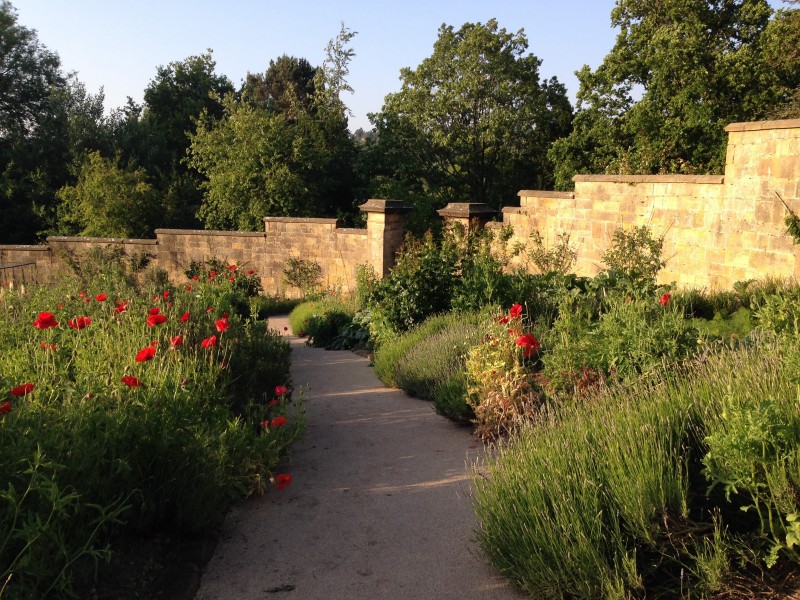
In a prior post, I wrote about the great William Robinson’s creation of the gardens of Gravetye Manor, a 16th century manor house sitting on over a thousand acres in West Sussex, England. Will Ingwerson, a neighbor and owner of a nursery on adjacent land, summed up Robinson well in an introduction to Robinson’s tome Gravetye Manor or Twenty Years’ Work Round an Old Manor House: “During his long and eventful life, Robinson was at odds with many established horticultural conventions and preached his own Gospel of Gardening. . . . He did not suffer fools gladly, and made enemies — but what revolutionary with ideas ahead of his time does not? . . . Our gardens of today owe a great debt to William Robinson.”
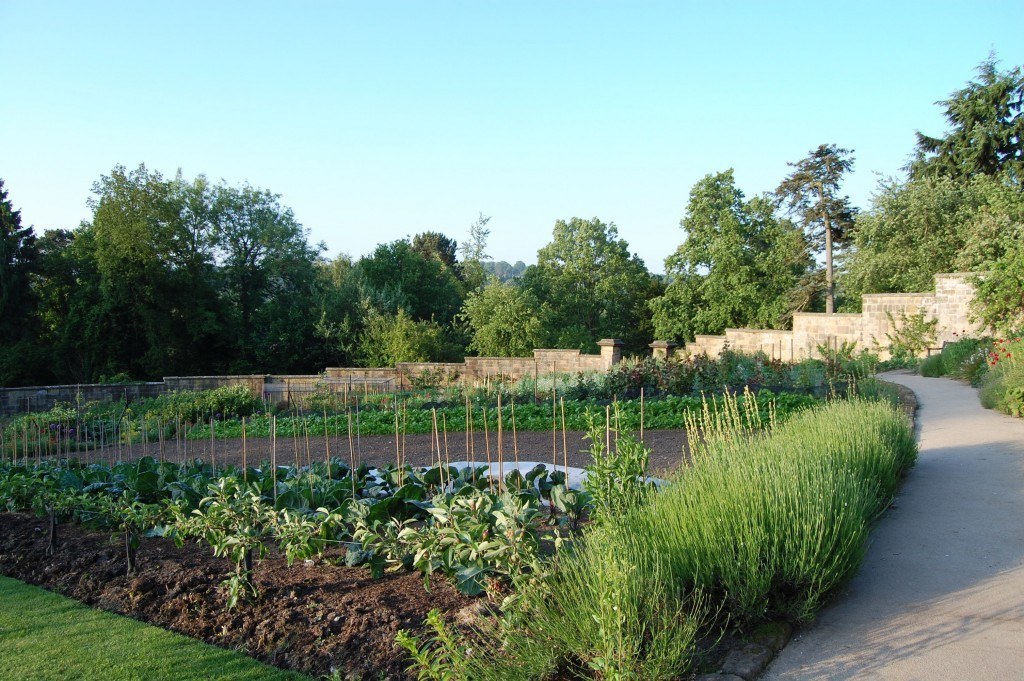
The kitchen garden, one of the last great kitchen gardens in the English countryside, was so spectacular that I felt it needed its own blog post.
When Robinson began building his gardens in 1885, he immediately dismissed the present location of the kitchen garden. “Determined to do away with the old kitchen garden, which was right against the house and had a poor effect,” he wrote in Gravetye Manor, p.1. Robinson had the walls torn down and began an orchard in its place.
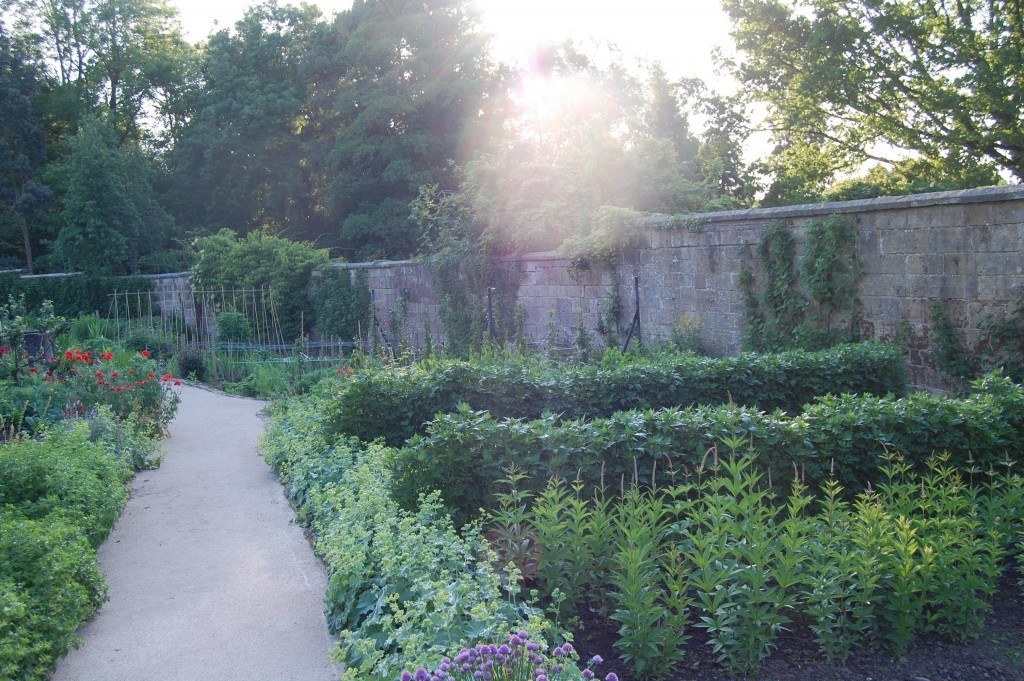
In 1898, Robinson turned his attention to a new kitchen garden. Ingersoll wrote, “true to his early days in horticulture he created, above the house, a mighty circular walled garden for fruits and vegetables. It was completed in 1900 and was a major engineering feat, being laid on sloping ground facing south.” Gravetye Manor, p. xiv.
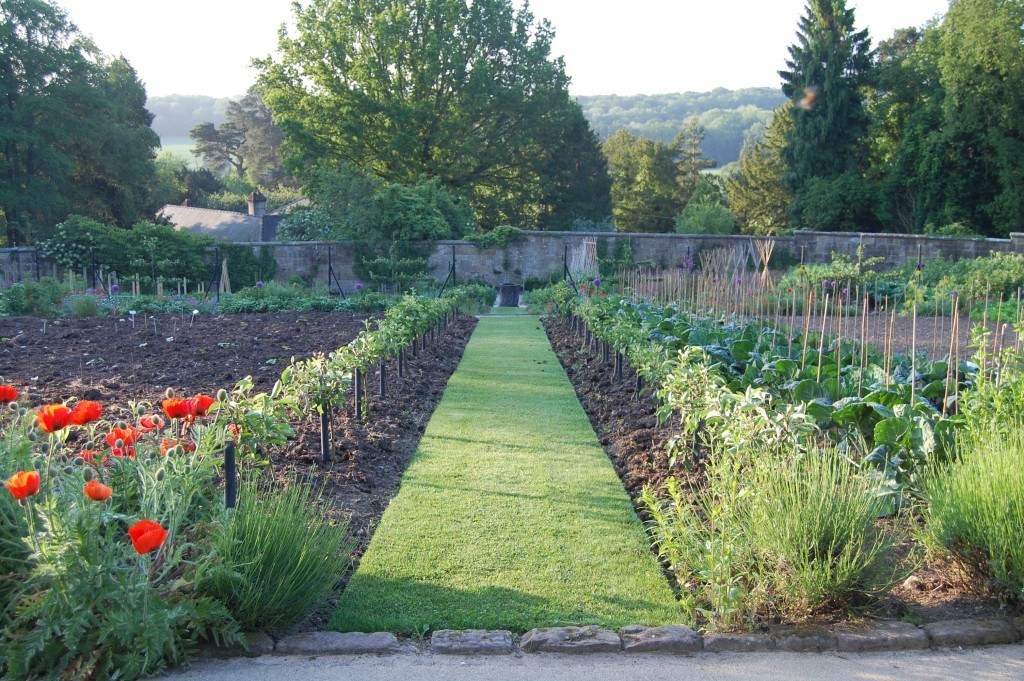
Robinson wrote, “Commenced to build in early Summer a stone wall round new kitchen garden, chosen after much and long thought as to the site. For various reasons chose the open hill above the House (where the spring that supplies House arises) as the best, and indeed only good, site near the House for the kitchen garden.” Gravetye Manor, p.108.
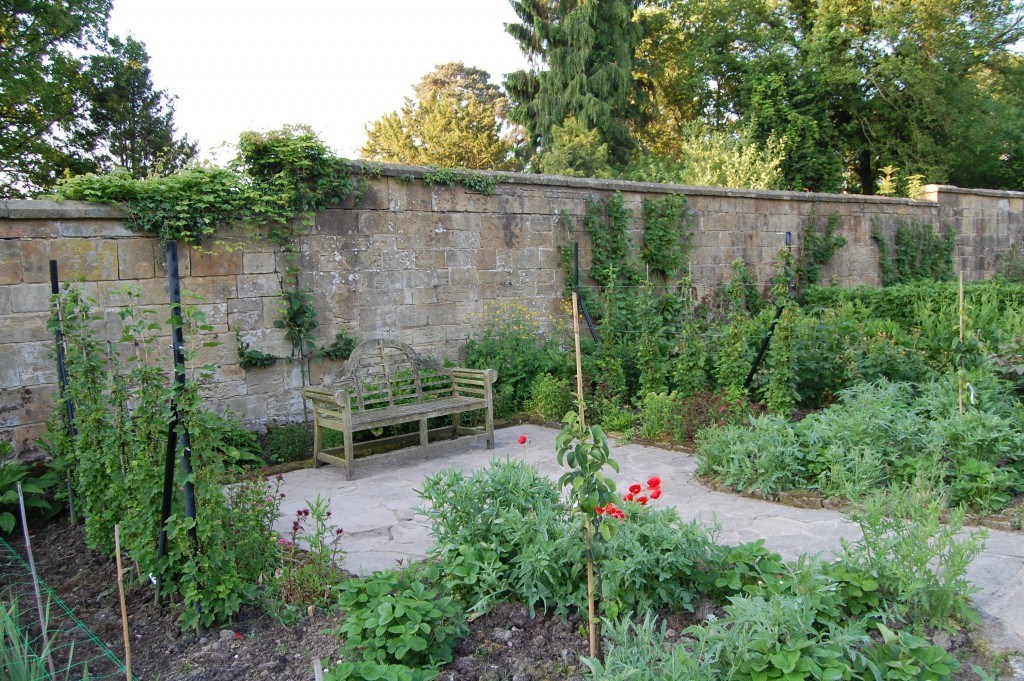
Robinson used sandstone, quarried on his own estate, to build the 12 foot high walls that enclosed one and a half acres for the garden. As Francine Raymond wrote for The Telegraph, the garden was angled to catch the light and the sun’s warmth, and to take advantage of the shelter the walls provided (click on Raymond’s article for an aerial photograph of the garden to fully appreciate its layout).
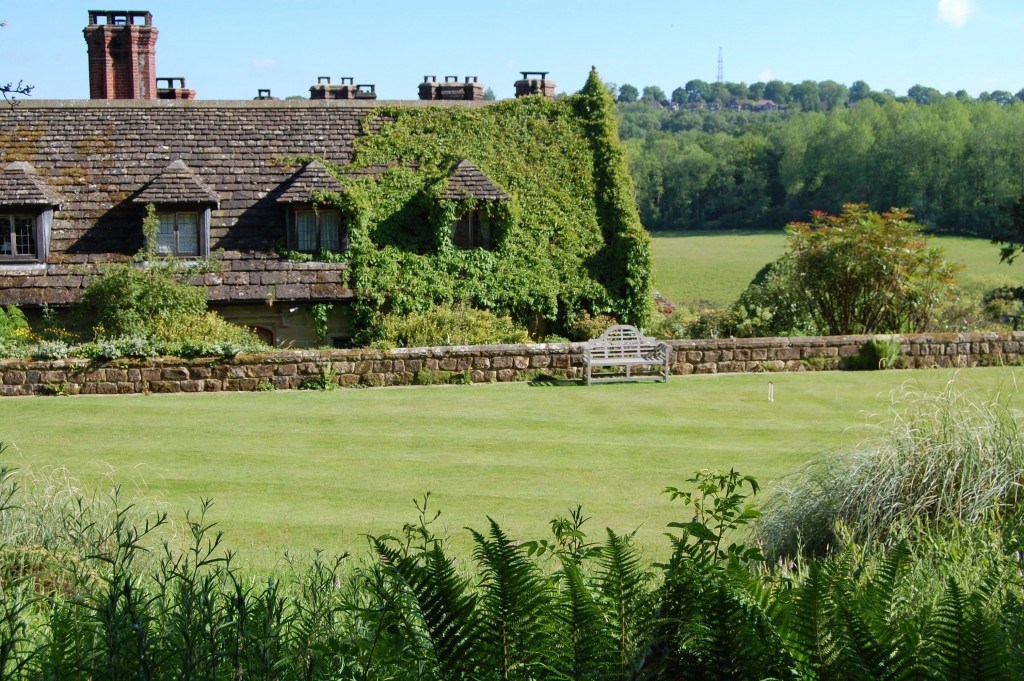
Robinson’s garden design provides rewards for the garden stroller every step from the house to the kitchen garden. After passing through the formal gardens, up the stone steps, and across the croquet lawn (above), a dramatic iron gate with stone columns beckons up yet another incline (below) — this time through one of his “wild” woodland gardens.
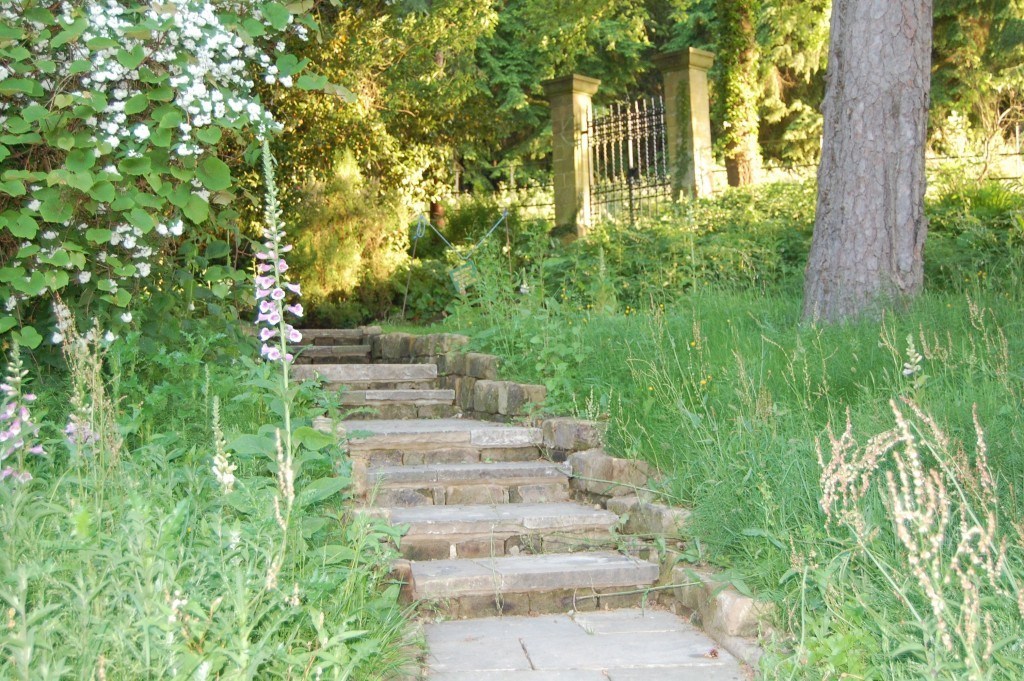
Just outside the kitchen garden gates is a rose-covered shed that, on the day I visited, was just about to burst into blooms (below).
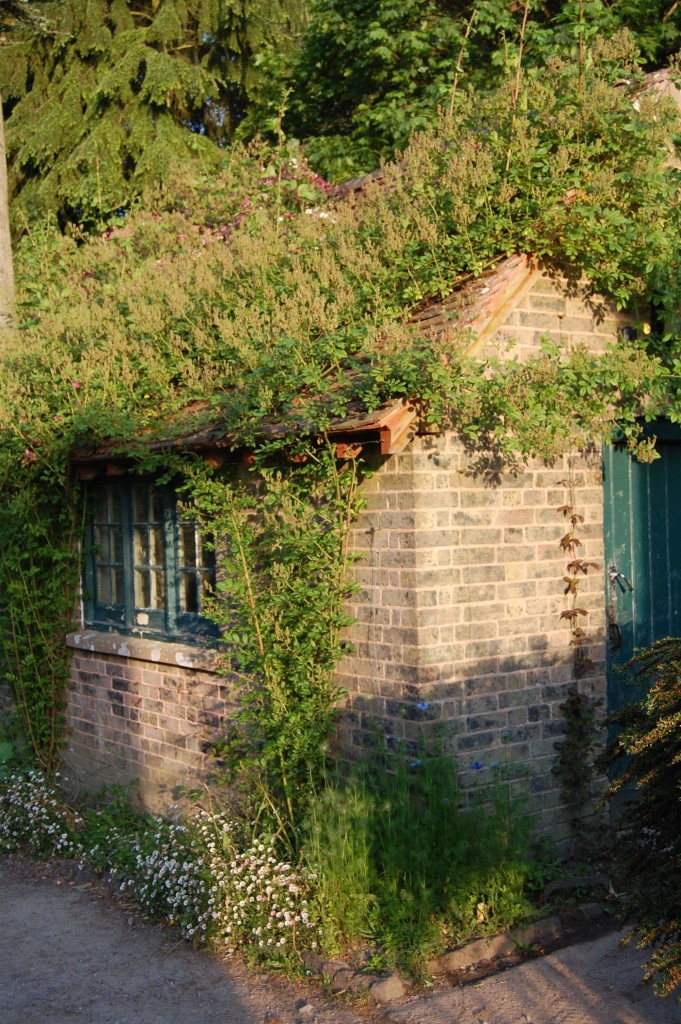
The sun rises early in England in June. Dying to walk the grounds at sunrise, I dragged myself out there at 5 am, too late to catch the crack of dawn, but close enough. When I stepped through the heavy iron gates into the kitchen garden, I was blown away.
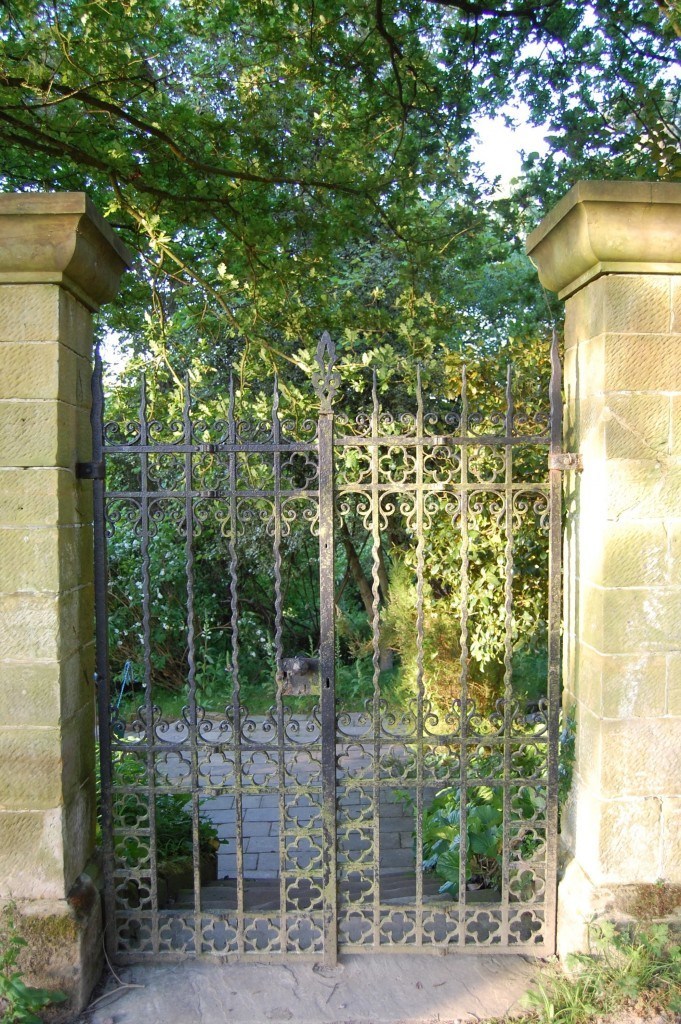
Head gardener Tom Coward’s horticultural expertise and willingness to innovate are evident everywhere in the kitchen garden. Ninety-five percent of the fruits and vegetables served at Gravetye are grown there.
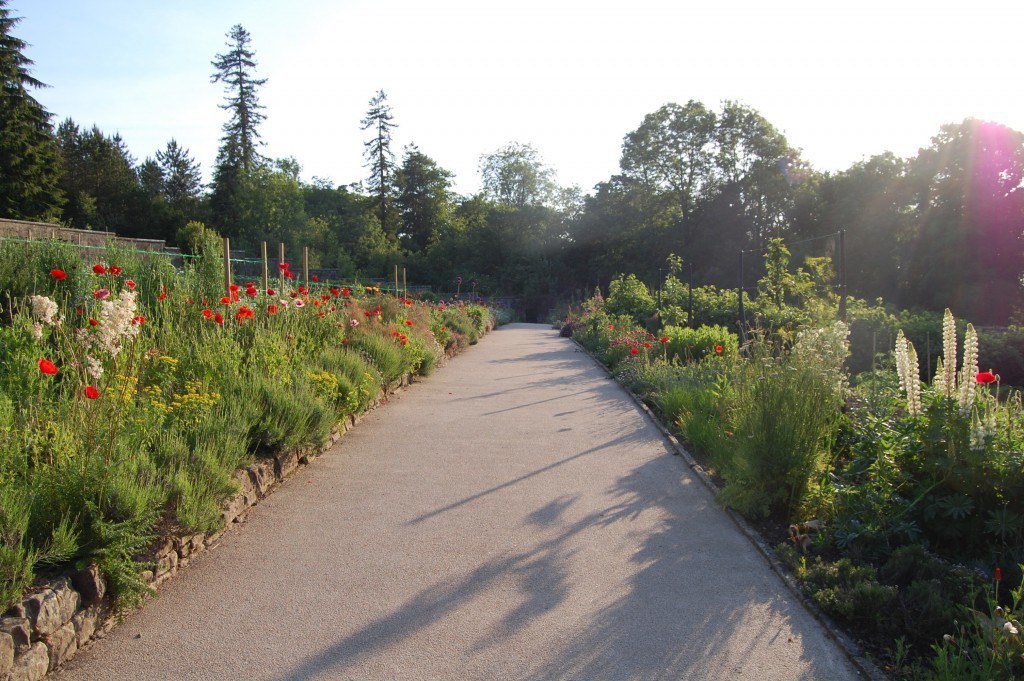
Upon stepping through the quatrefoil iron gates, a wide center path runs east-west down the center of the garden, and is intersected in the center by a similarly wide path running north to south. Another path circles the garden, bisecting the rows of vegetables, herbs, fruits and flowers.
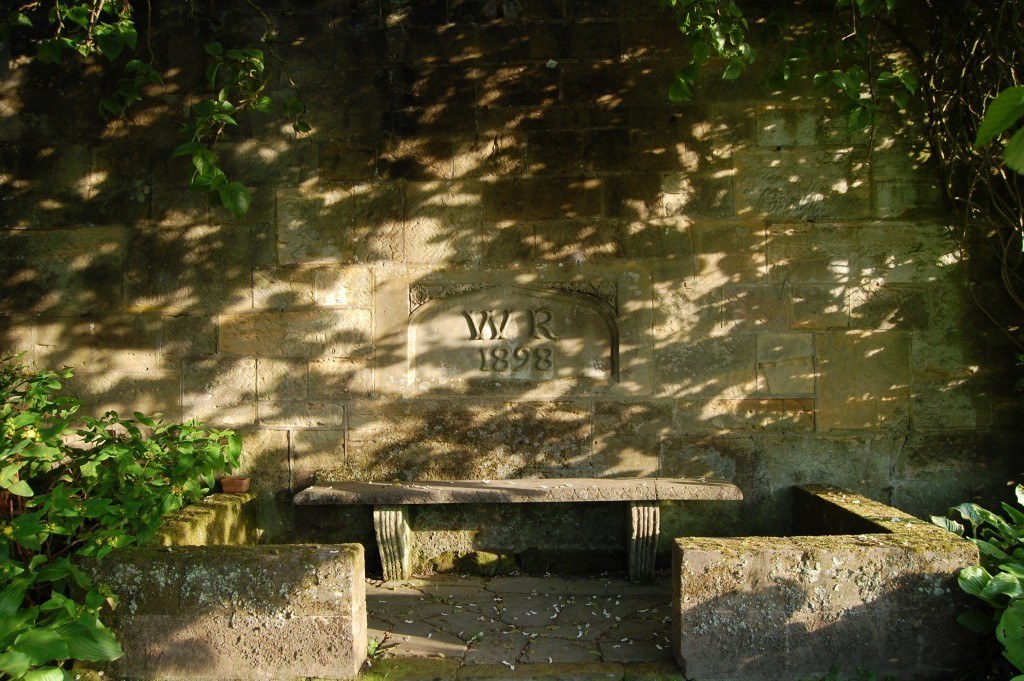
At the north terminus is a lovely stone bench and etching paying homage to Robinson, and signifying the year the workmen began to build the garden’s sandstone walls (above).
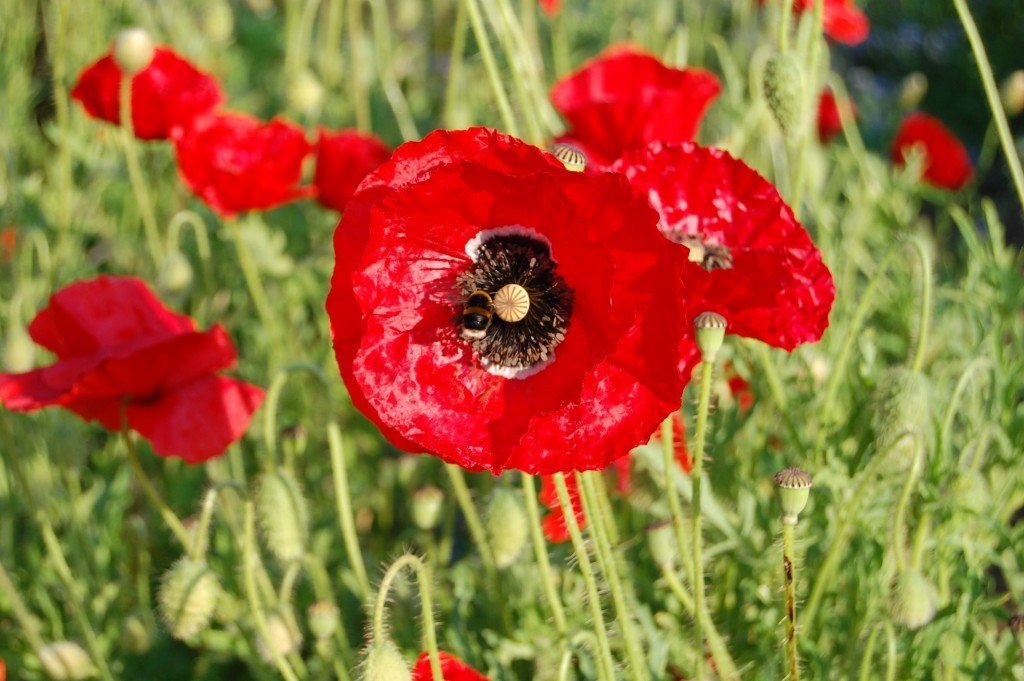
Flowers abound in the kitchen garden. They serve the dual purpose of providing cuttings for arrangements throughout the house (below) and a pollination source to ensure continued productivity (above).
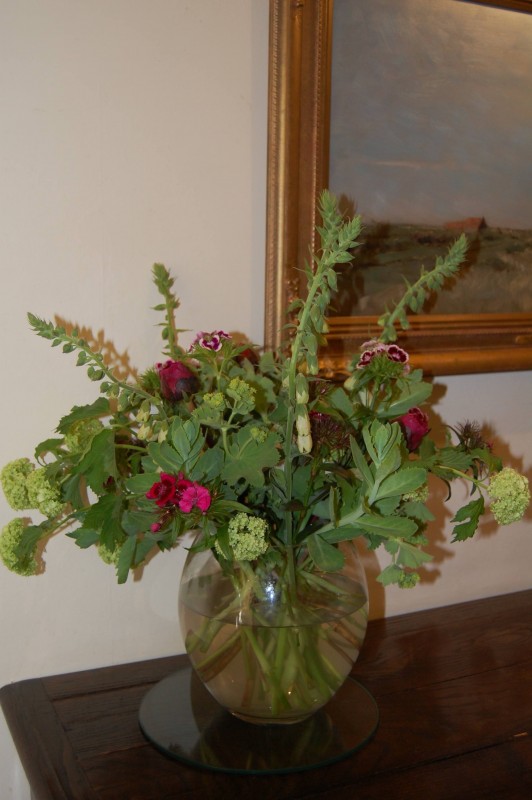
According to Raymond, the gardeners moves the bantam hens around the beds, so that they can fertilize and scarify. Of course, they also provide eggs for the kitchen.
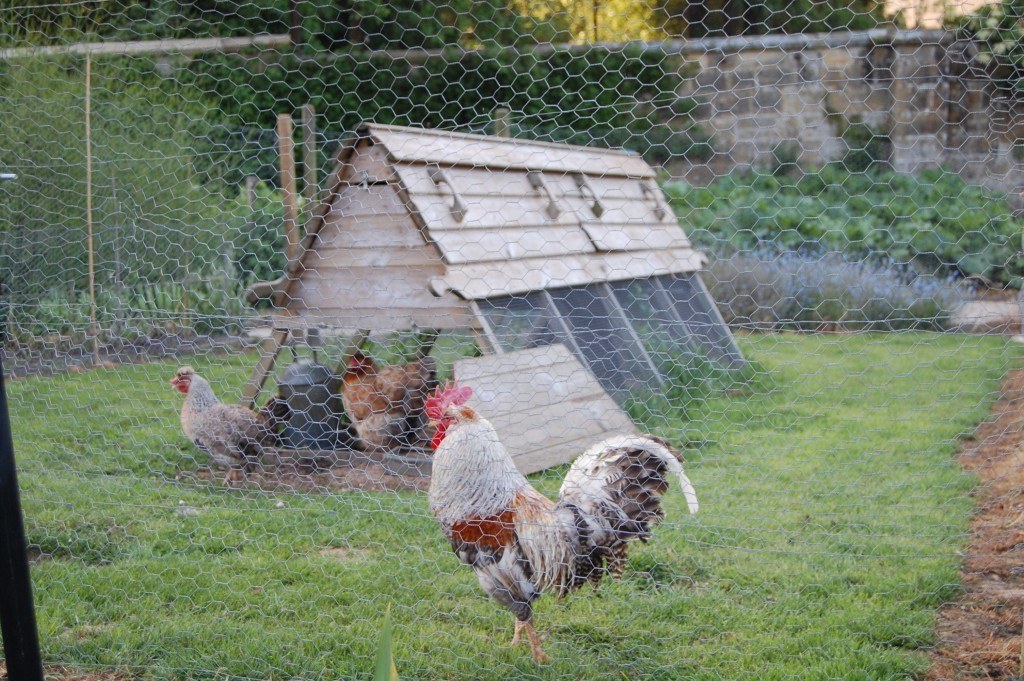
Since I visited in June, Gravetye Manor’s restaurant was awarded its first Michelin Star. Chef George Blogg’s close working relationship with Coward is crucial to the success of the manor’s kitchen. According to Raymond, the men “get together with the seed catalogues over a pre-Christmas drink and decide quantities and varieties, and then place their order”, always experimenting with new varieties. Coward keeps a “cropping diary so the kitchen knows what’s available for the menus, and the chef visits the garden every day.”
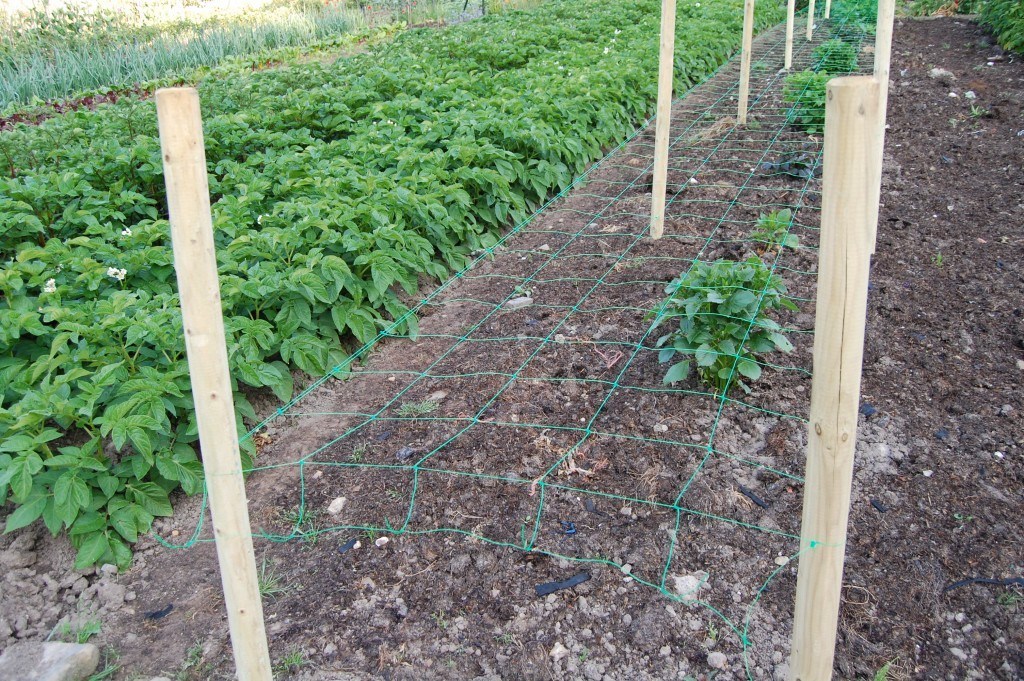
I filed away (for the veggie garden I will try to bring back to life this year) this effective method of plant spacing.
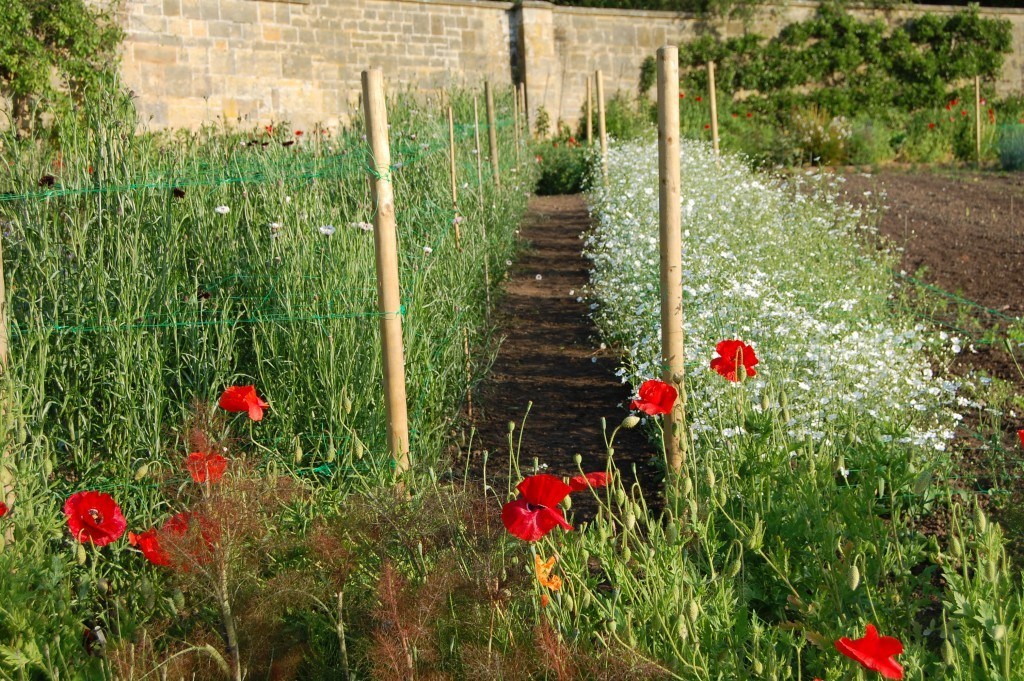
Raymond noted in her article that Coward uses homemade potting compost made from local horse manure, “green manure from the plot and debris from the henhouse. The mixture is turned three times with a tractor.”
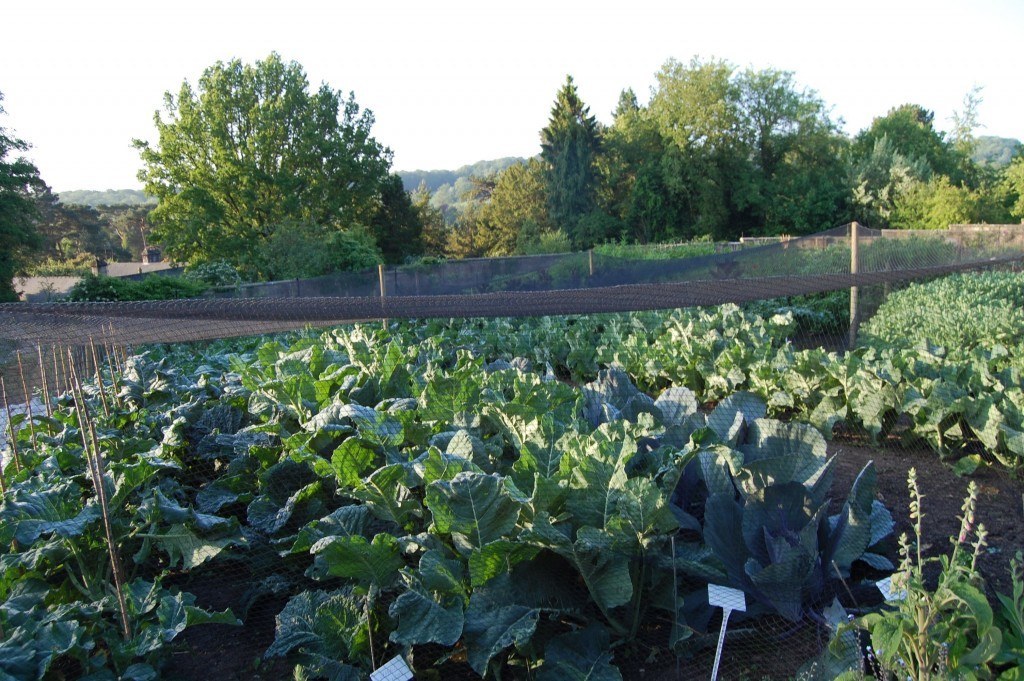
I enlisted the help of my good friend Clare Shapiro— Richmond’s resident foodie expert — to identify some of the plants grown in Gravetye’s kitchen garden. Clare generously took the time from her crazy schedule writing her column, filming her show and working on her upcoming book to help me out. She used it as a time-honored gardener’s excuse to sit down by a cozy fire and lose herself in old gardening books — in this case, her mother’s old English gardening books.
Clare thinks the leafy vegetable above is purple sprouting broccoli. This may be post-harvest of the stalks, as the PSB (as it’s called by the Brits) peak harvest ends in May. I had never heard of PSB before, so Clare steered me toward an article by one of her favorite British food writers, Hugh Fearnley-Whittingstall, who wrote about it for the Guardian.
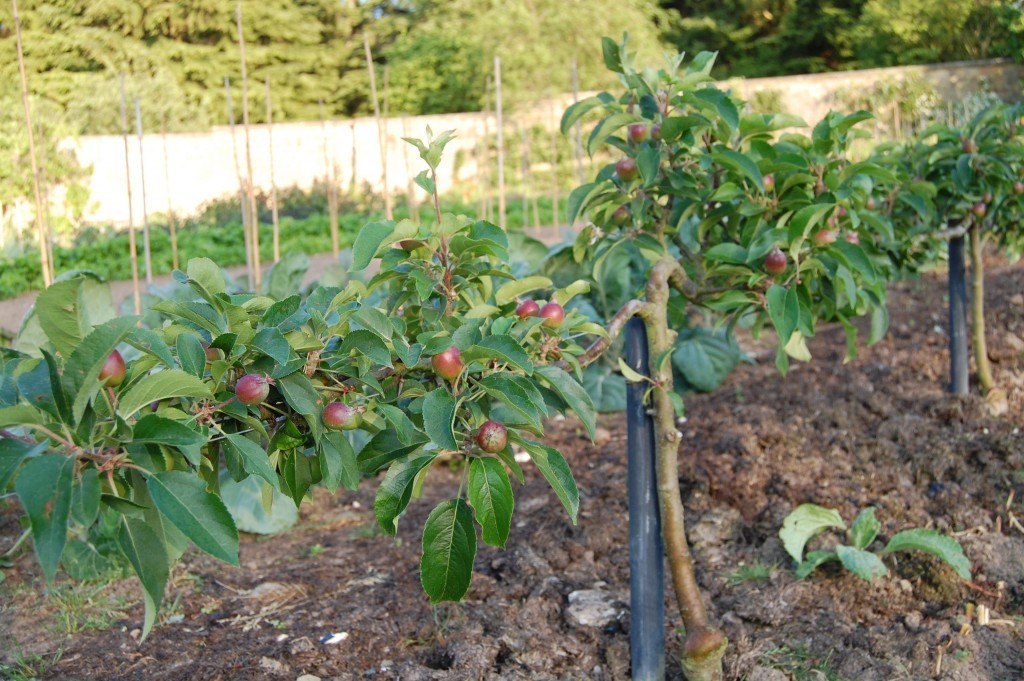
Gooseberries (Ribes genus) (above). I thought they were young apples or pears!
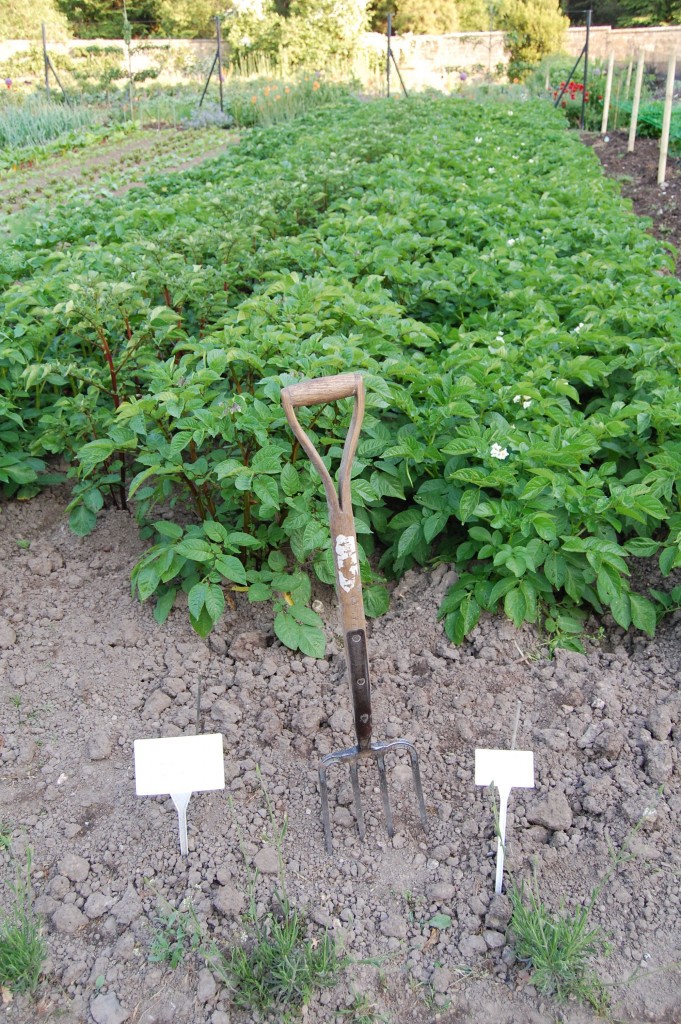
Young raspberry plants (Rubus, genus) (above)
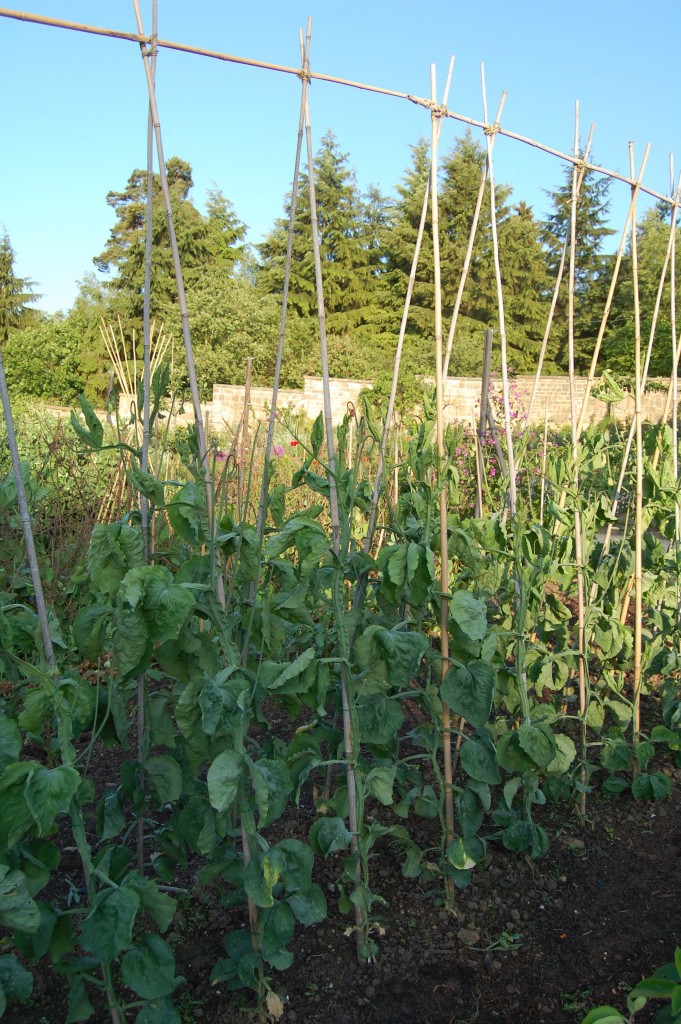
Red-flowering Runner Beans (above).
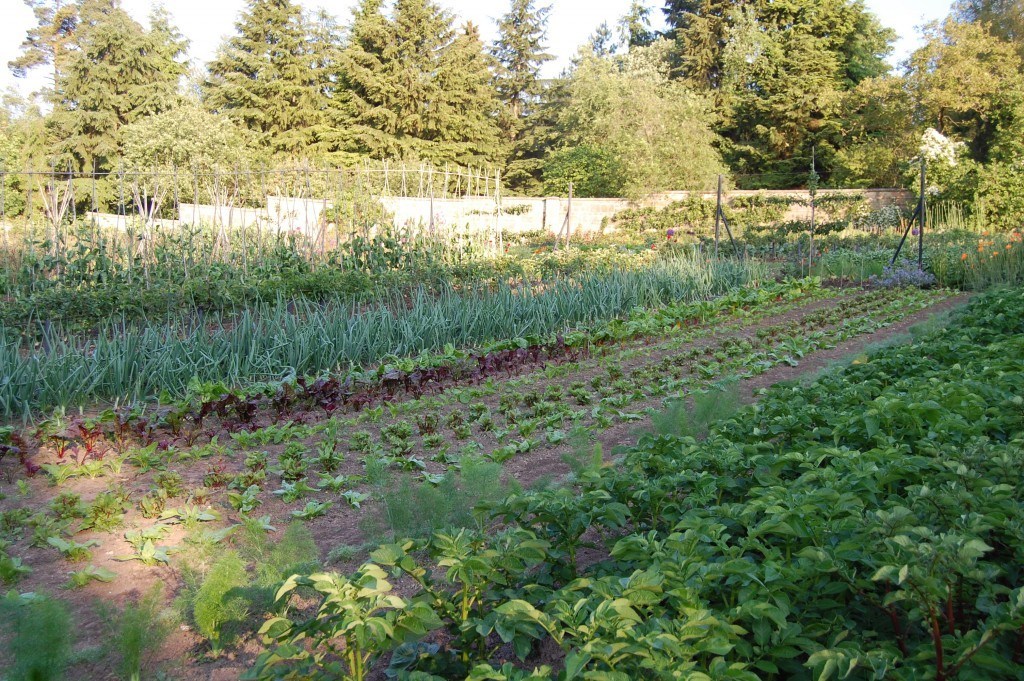
For more pictures of the garden, see the Gravetye Gardener’s Journal.
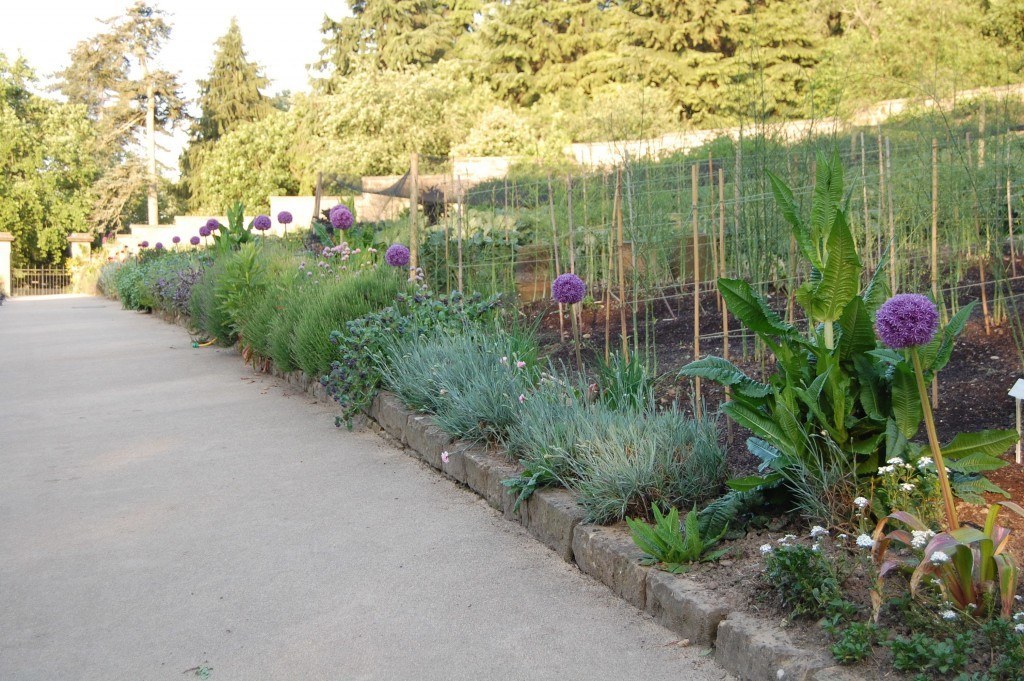
Early spring vegetable planting is just around the corner. Until then, get out those seed catalogues!
[custom-related-posts title=”Related Posts” none_text=”None found” order_by=”title” order=”ASC”]
ROBINSON’S MASTERPIECE: GRAVETYE MANOR
As winter finally sets in, I thought I’d distract you from the cold weather by taking you across the pond to gardens in lovely England. I plan to do a handful of blog posts on the exceptional gardens I visited last June, and I begin with the grounds of Gravetye Manor.
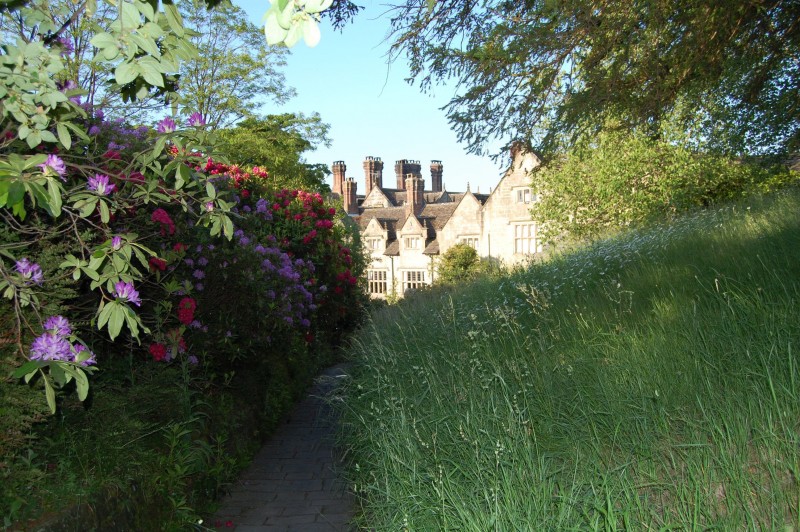 In 1884, William Robinson began a decades-long journey to put his revolutionary landscape philosophy into practice at Gravetye Manor in England’s lush Sussex County. When he began his work, the vast grounds of the manor house, built in 1598 by Richard Infield, had been used primarily for livestock grazing. Vast woodlands made up much of the remainder of the estate.
In 1884, William Robinson began a decades-long journey to put his revolutionary landscape philosophy into practice at Gravetye Manor in England’s lush Sussex County. When he began his work, the vast grounds of the manor house, built in 1598 by Richard Infield, had been used primarily for livestock grazing. Vast woodlands made up much of the remainder of the estate.
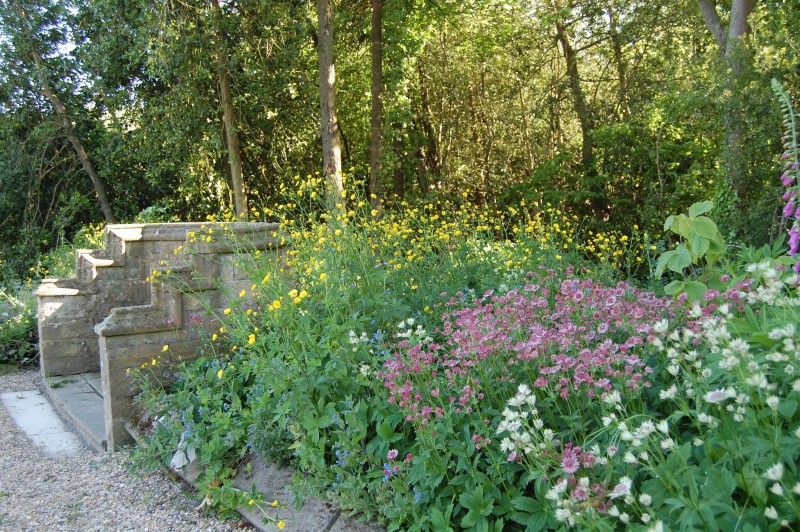
Robinson, a prolific garden writer (The English Flower Garden is legendary), was a leader in the movement toward the Wild Garden (he wrote a ground-breaking book of the same name). He rebelled against the rigid formality of the Continental landscapes, writing, “the greatest and the most lasting improvement ever made in English gardens was the breaking away from the old idea of gardens of barrack-yard uniformity.”
After Robinson’s death, the Manor was neglected until hotelier Peter Herbert undertook a renovation of the house and garden in 1958, guided by Robinson’s meticulous writings about his work on the property in the book Gravetye Manor; Or Twenty Years’ Work Round an Old Manor House. Herbert transformed Gravetye Manor into a glorious country house hotel, restaurant and garden. After Herbert’s retirement in 2004, the property again fell into neglect until Jeremy Hosking bought the property in 2010. Hosking made the brilliant decision to hire Tom Coward, below, as Head Gardener. Tom came to Gravetye with extensive experience, including time at Great Dixter under Fergus Garrett.
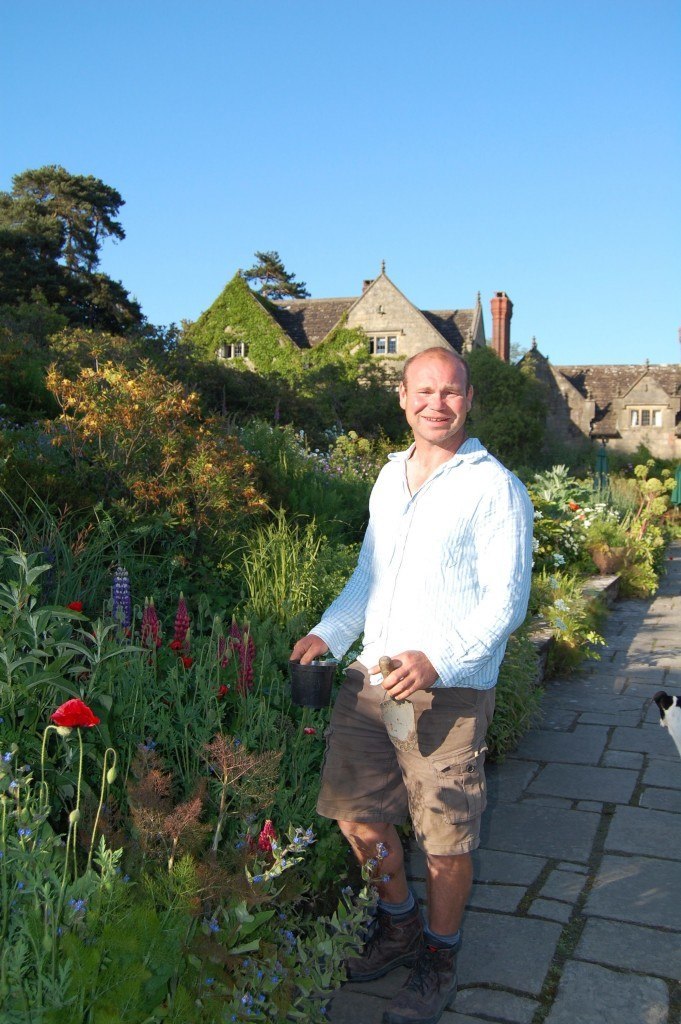
I had the luck of running into Tom during his evening stroll through the garden. It is obviously a time that he and his dog Vera cherish. This delightful man told me that this was the time he could reflect on the progress and challenges of the garden, and contemplate plans for the days, months, and years ahead, As he continued on his daily rounds (below), I found myself envious of Vera, wishing I could tag along to soak up just a sliver of Tom’s knowledge.
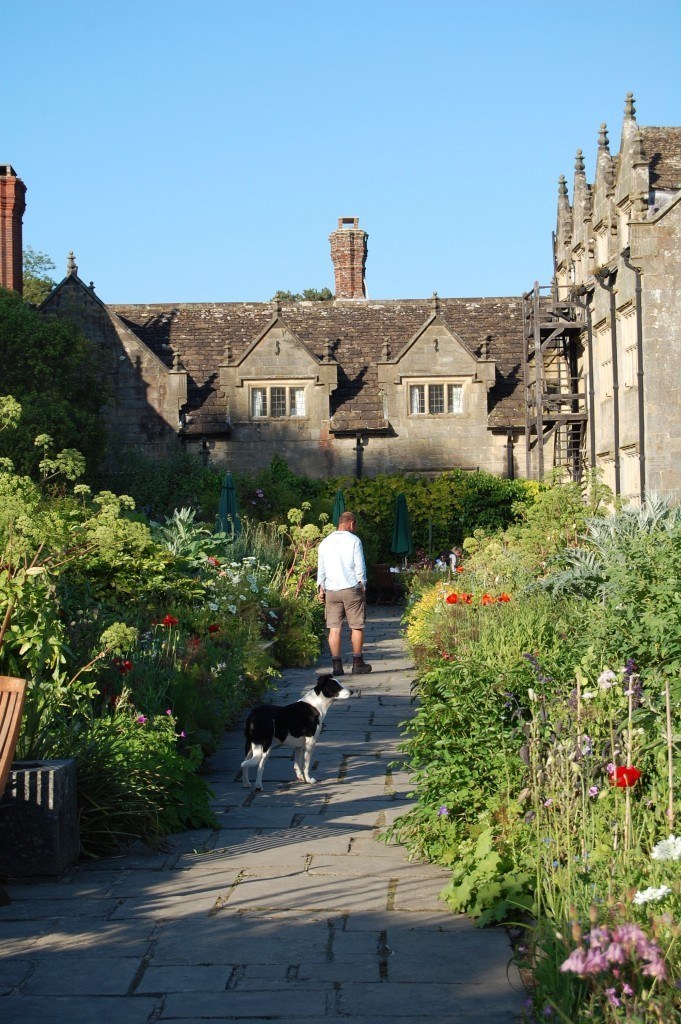
What Tom and his team of dedicated and talented gardeners have done at Gravetye is jaw-dropping. Their mission is “not only to conserve and re-create Robinson’s work but also to progress the garden in homage to his experimental style of gardening.”.
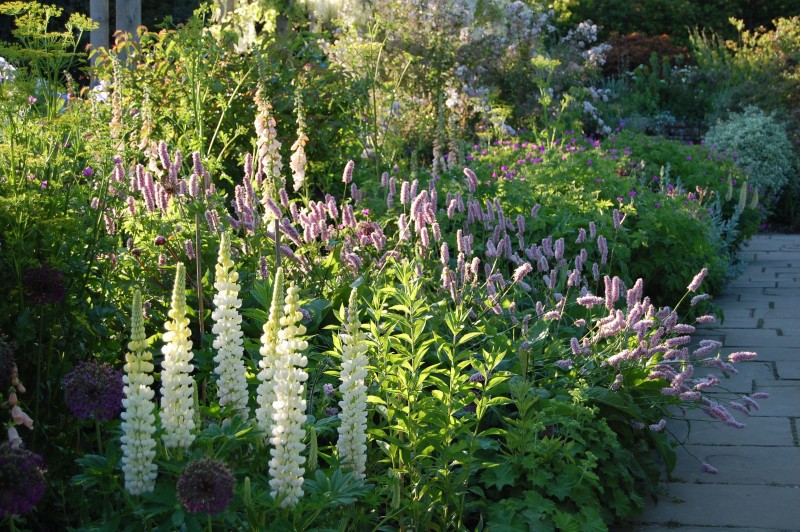
In a break from the formal Renaissance era gardens in continental Europe, Robinson looked to the land to lead the design. He wrote, “a garden should grow out of its own site, if we are to have the best of it. One should think of the spot and what can best be done in it, instead of following set models.”Robinson’s formal layout adapted to Gravetye’s topography, transitioning to the rolling fields with a rustic arbor (recently rebuilt) and more loosely defined beds and plantings, below.
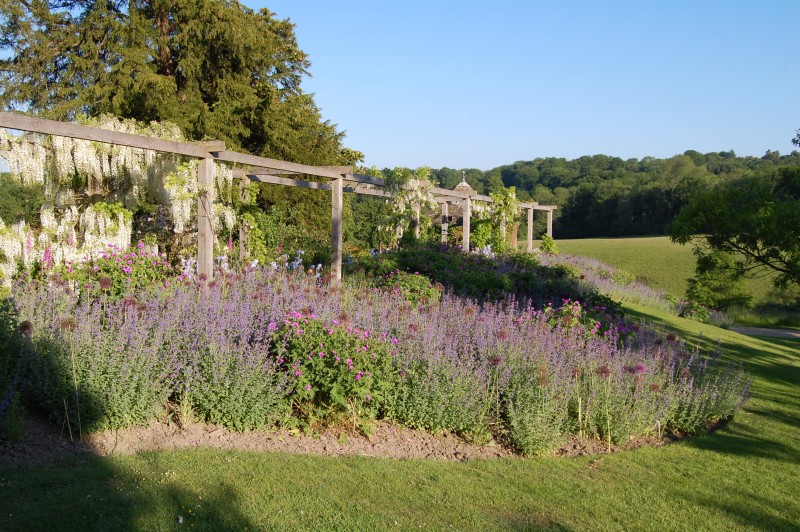
The arbor is draped in White Wisteria and underplanted with soft violet Bearded Iris.
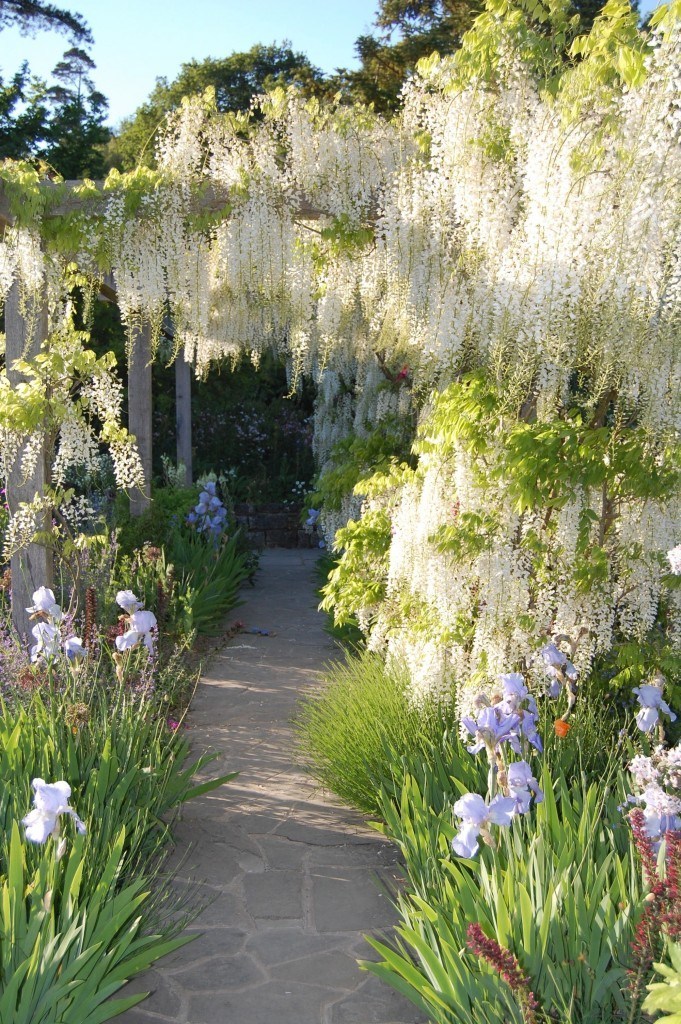
Eschewing the practice of “bedding out” so popular at the time, Robinson instead sought to create planting schemes more in keeping with the patterns and groupings found in nature. He said, “Almost everything was planted in groups, varying the sizes and shapes, holding some apart and some together by turfing plants beneath and spaces of repose around, letting other groups merge one into another, suitable plants intermingling. This destroyed all set pattern to such an extent that it was impossible for the eye to take in the arrangement or contents of any single bed from one standpoint.
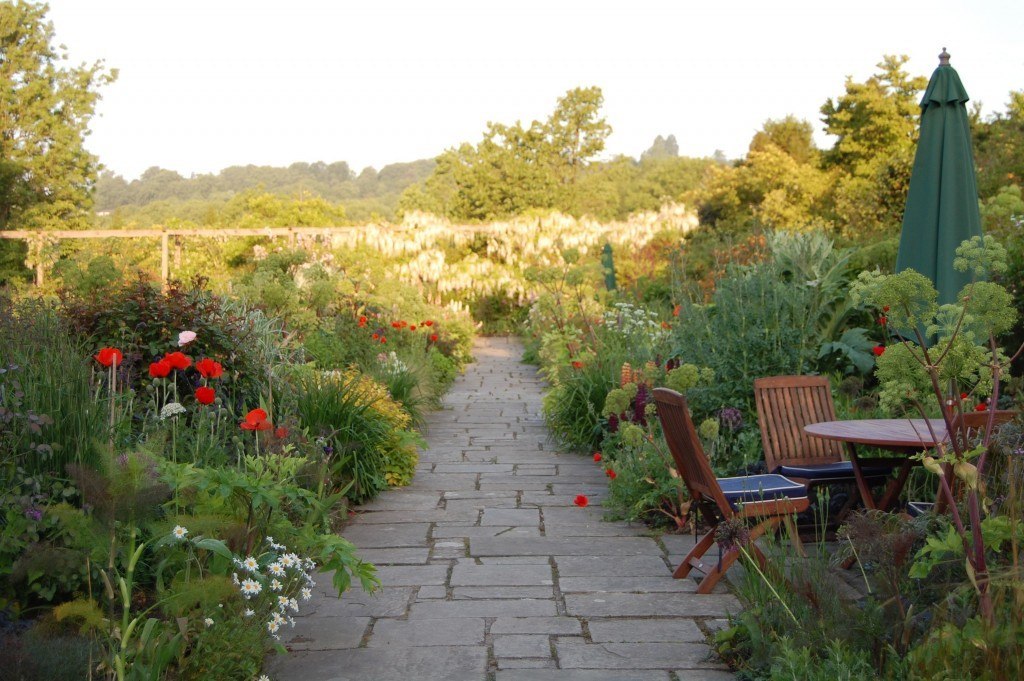
Robinson wrote, “before the English invented and carried out landscape gardening, the foreigner, like ourselves, was content with the mason’s idea of a garden.” By that, he meant, “so few plants that architects made gardens of stones and a few clipped trees with geometrical tracery.”
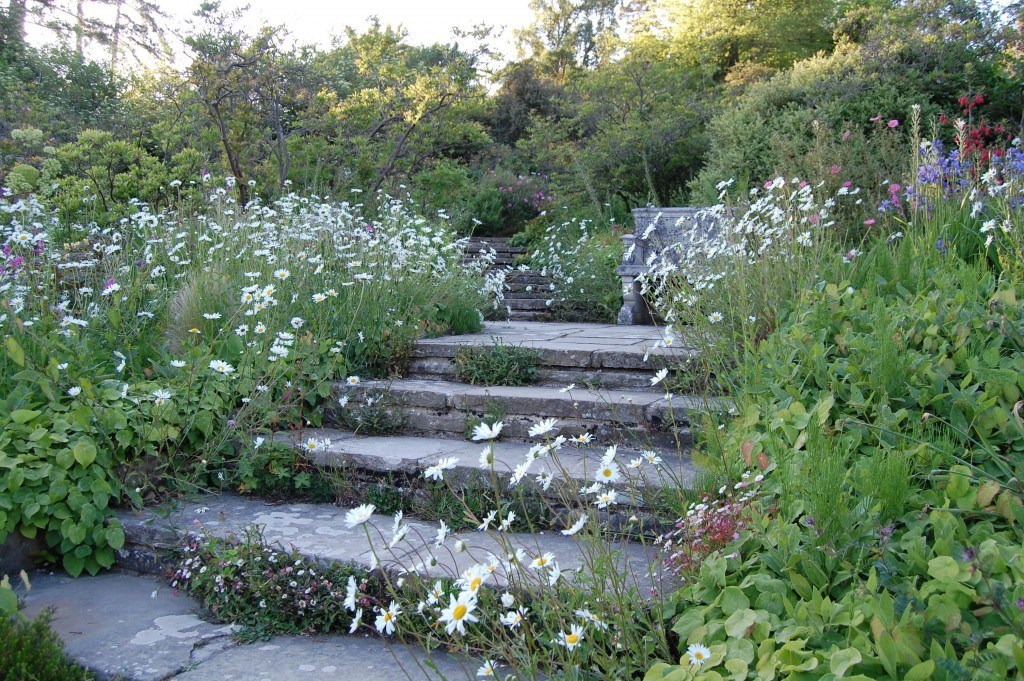
Don’t mistake Robinson’s disdain for the mason’s garden with a dislike for use of stone in the garden. Gravetye Manor is a testament to Robinson’s brilliance in using hardscape to shape and define a garden. The stone steps, above, illustrate his talent for blending the functional and the beautiful. Here he softened the formal layout of steps by using an informal style of masonry and his wild style of planting schemes.
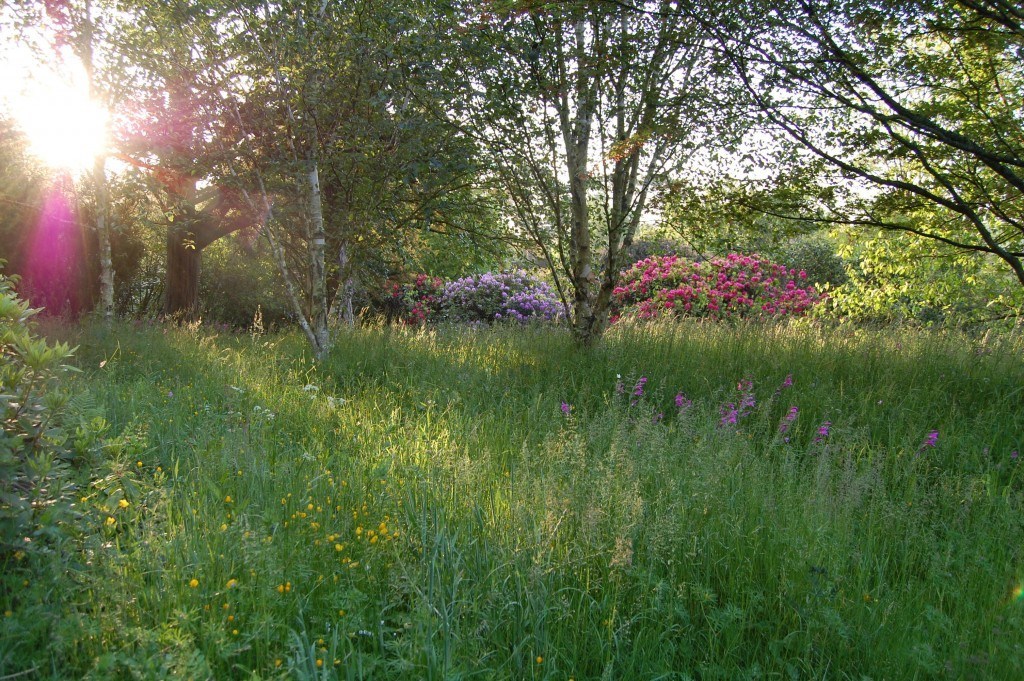
Robinson was extremely critical of the Europeans’ treatment of plants as mere instruments to create barriers or define geometrical spaces or boundaries. He wrote, “having seen for many years the evils of disfiguring trees and shrubs by clipping . . . I naturally did not follow a plan so evil in its results. It is a common cause of hard and ugly lines in gardens, and usually so needless as well.”
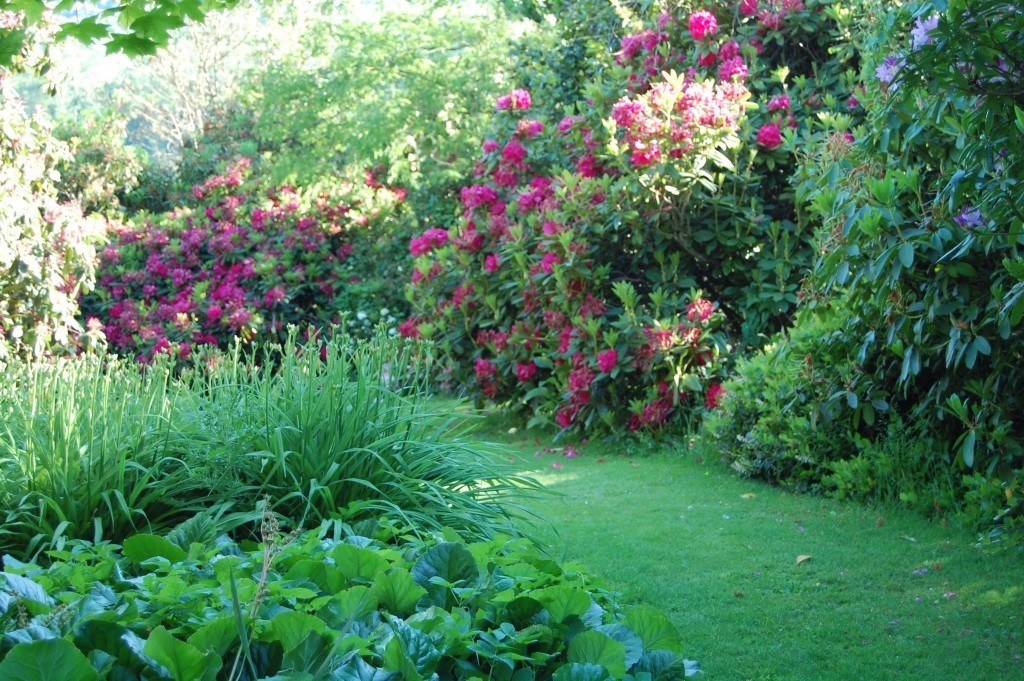
After years of begging landscapers to leave their hedge trimmers in their trucks when working on my clients’ gardens, and requiring only hand pruning of shrubs, I was ecstatic when I read the following from the great gardener: “we abolished the shears and clipped no more. . the forming of dividing lines and shelters should be easy without the aid of the shears.” In the picture above, a beautiful barrier was created using Rhododendron, not a formal hedge with all life and personality sheared out of it. How much more beautiful the hedge is when the Rhodos are allowed to maintain their natural graceful shape!
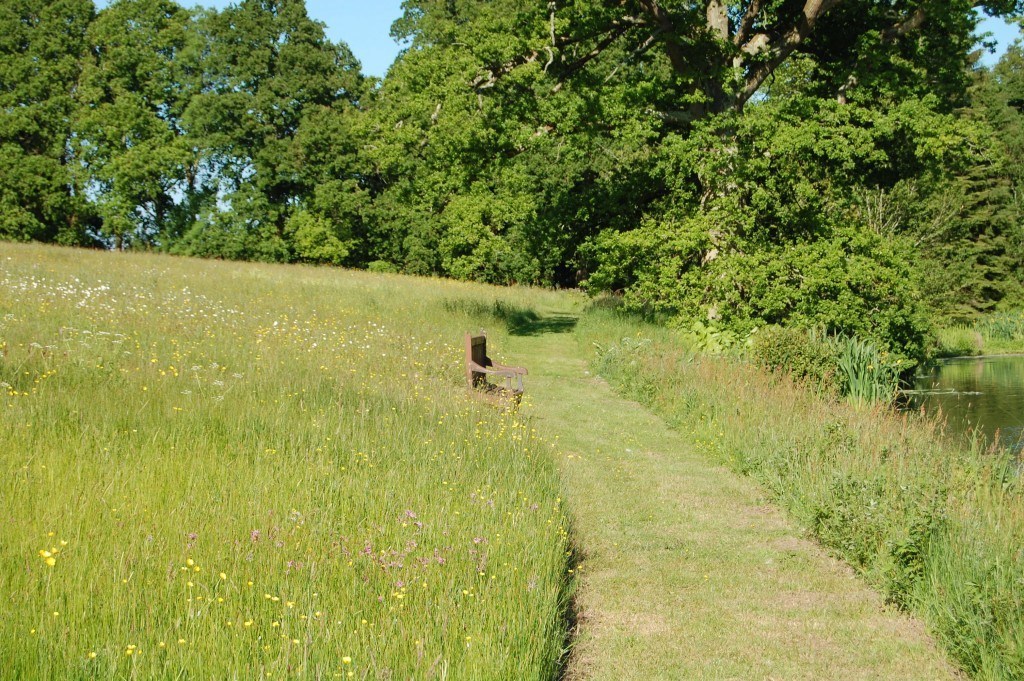 The meadows at Gravetye Manor are spectacular (above and below). Robinson was also a pioneer in replacing mowed turf with wild meadows, and in naturalizing bulbs. When I arrived, the spring bulbs had faded, and the summer wildflowers were in their glory.
The meadows at Gravetye Manor are spectacular (above and below). Robinson was also a pioneer in replacing mowed turf with wild meadows, and in naturalizing bulbs. When I arrived, the spring bulbs had faded, and the summer wildflowers were in their glory.
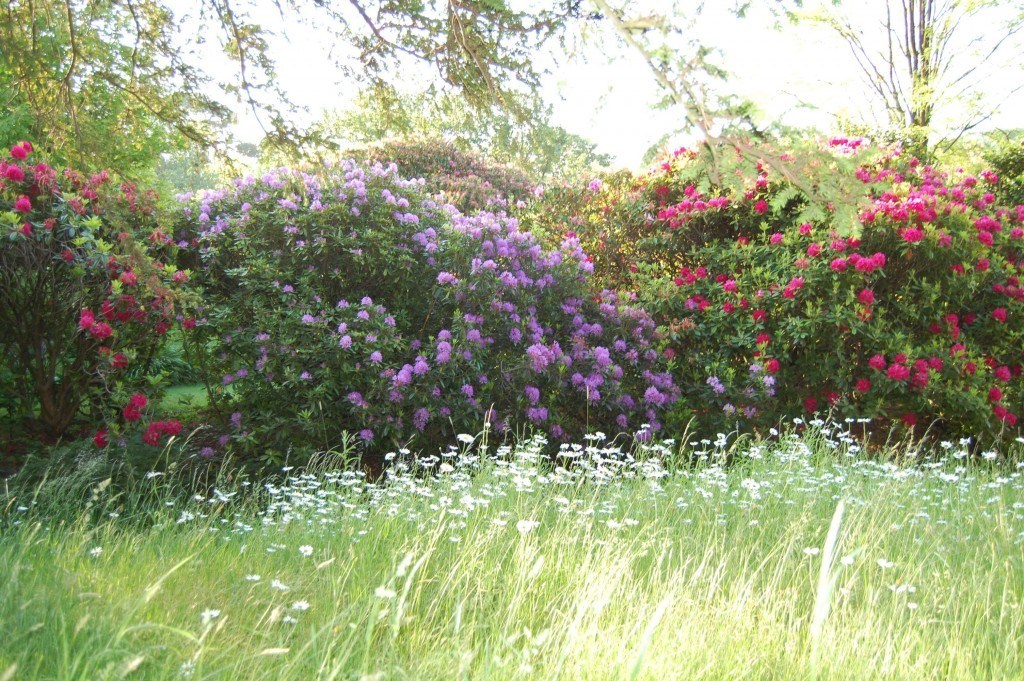
I may have missed the spring bulbs, but I’d say my walk along a carpet of Rhododendron petals more than made up for it. And that bark!
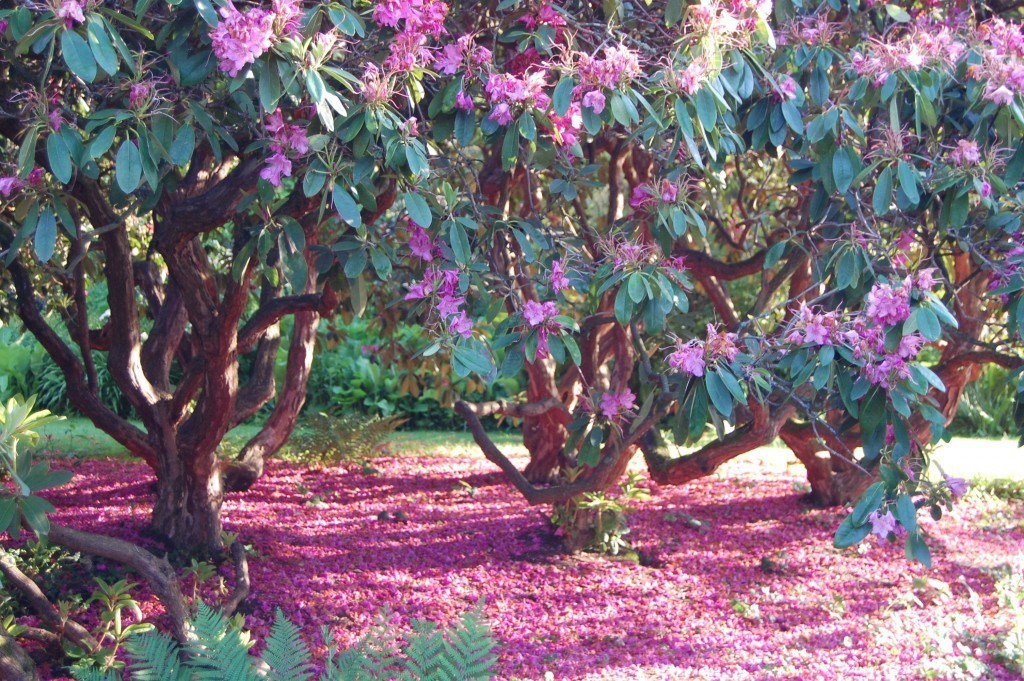
Enough discussion of this special place, its history and the immensely influential gardeners and patrons who have made it possible for the rest of us to enjoy. I leave you with a few more images to soak in until you, too, can walk the paths of Gravetye Manor’s gardens.
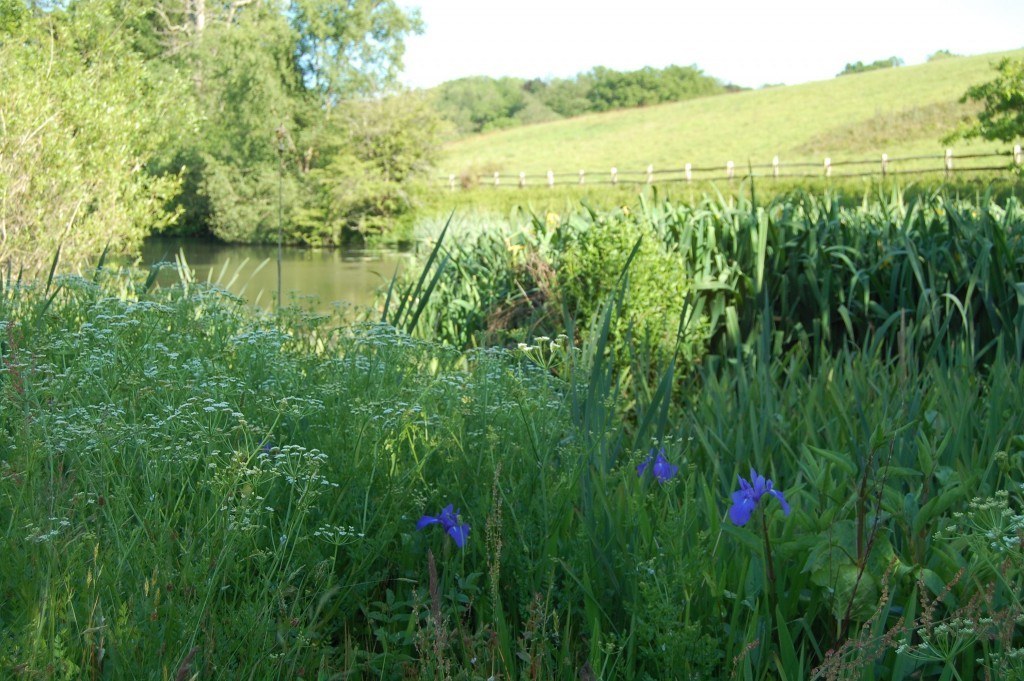
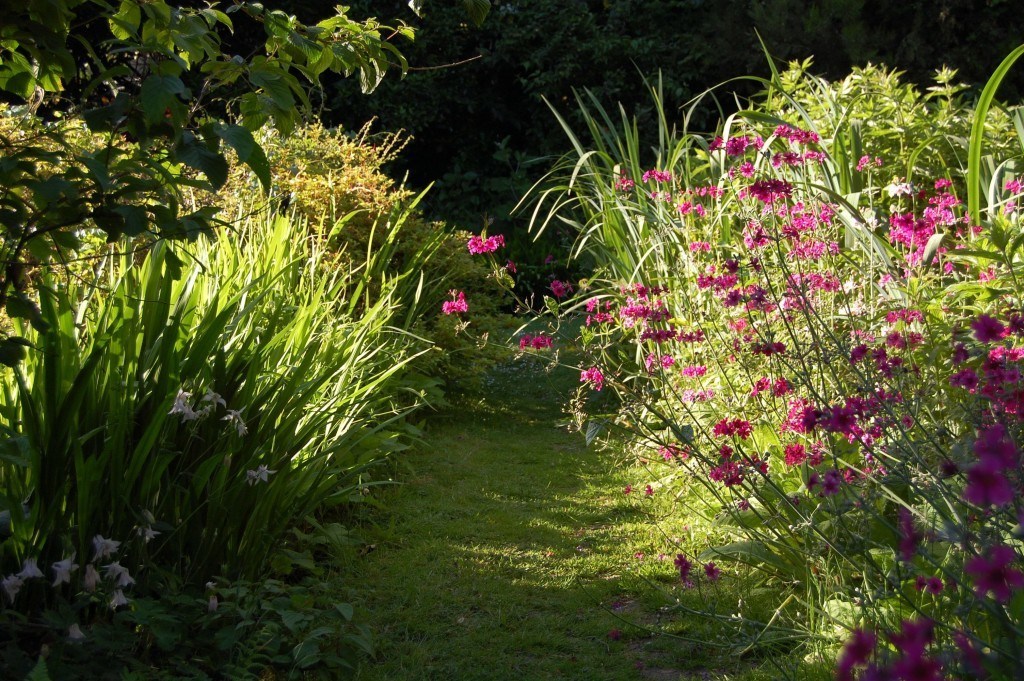
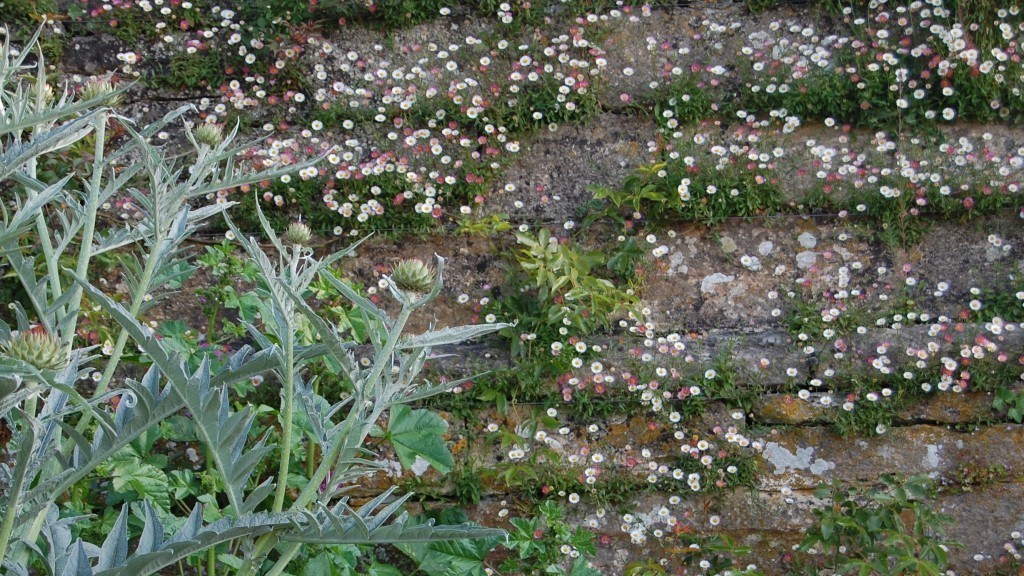
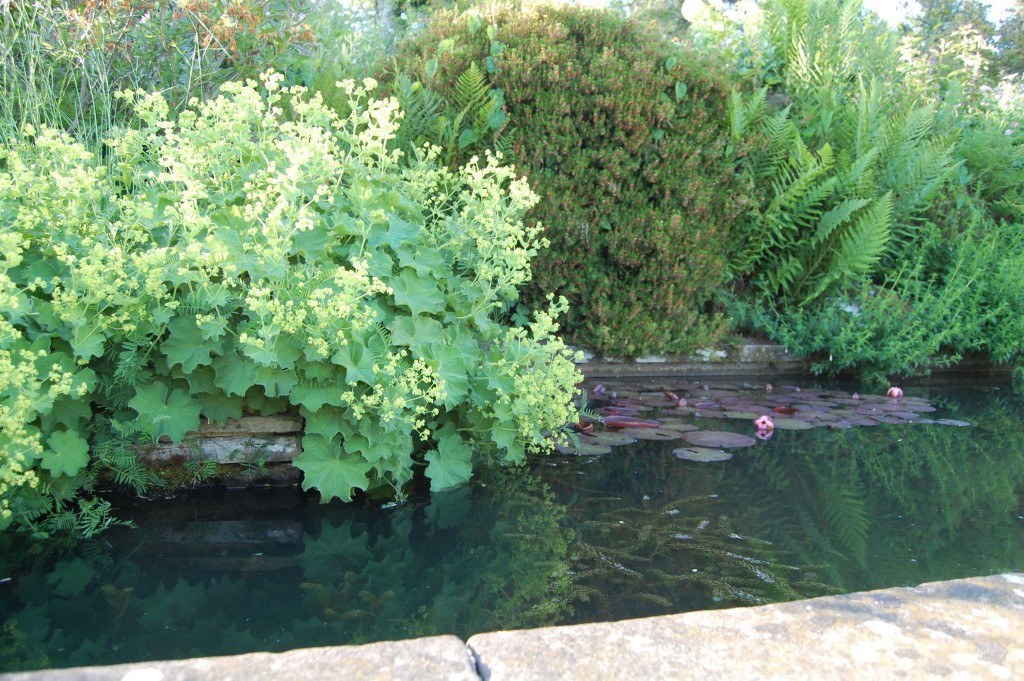
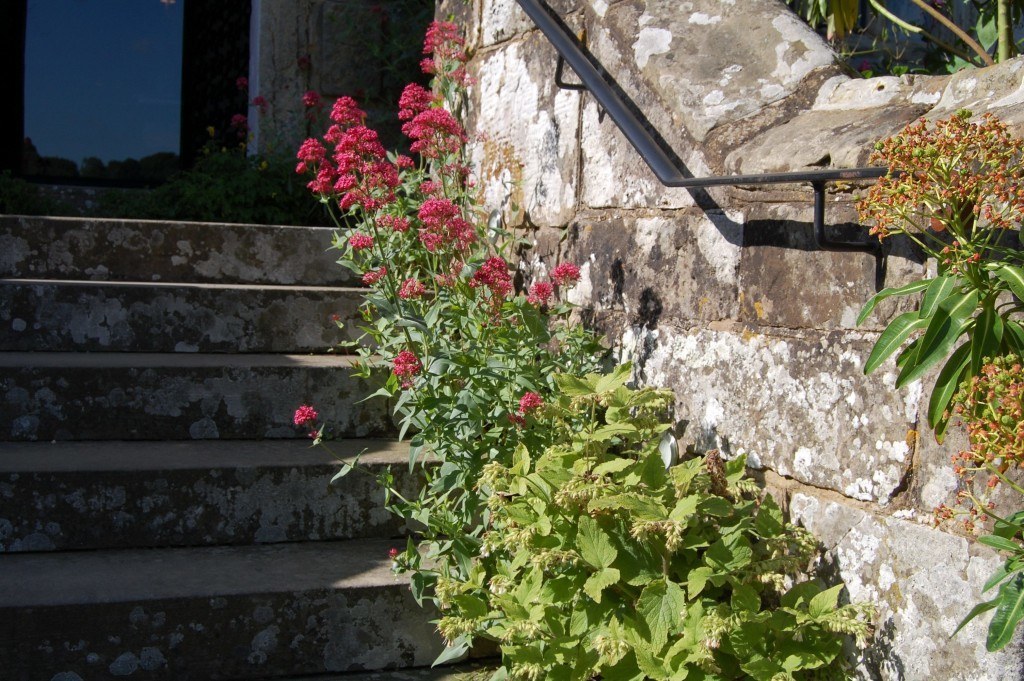
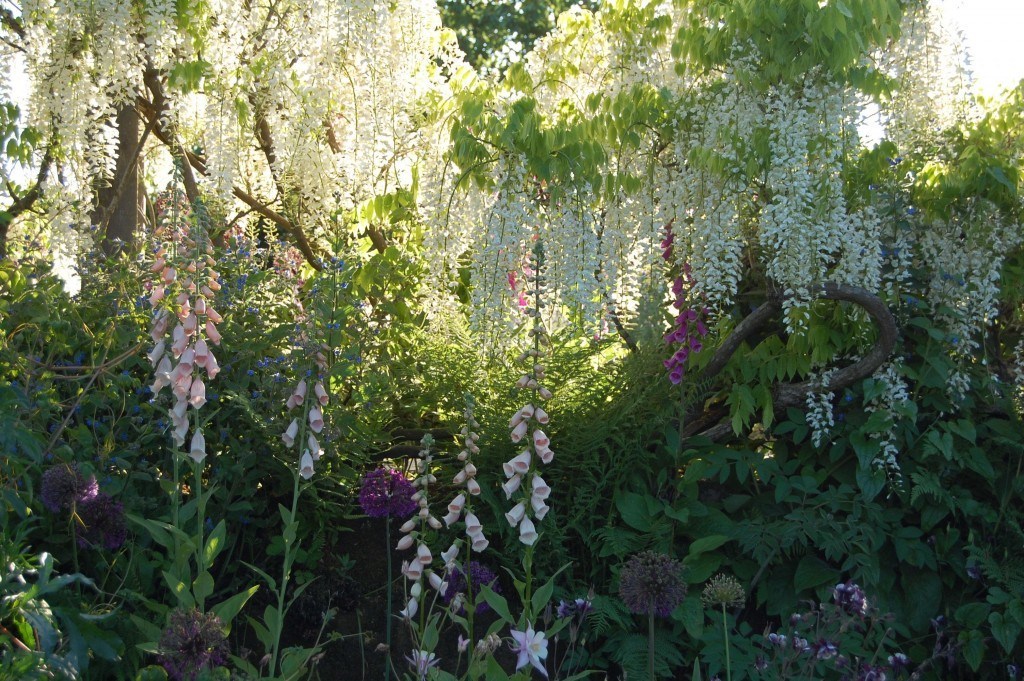
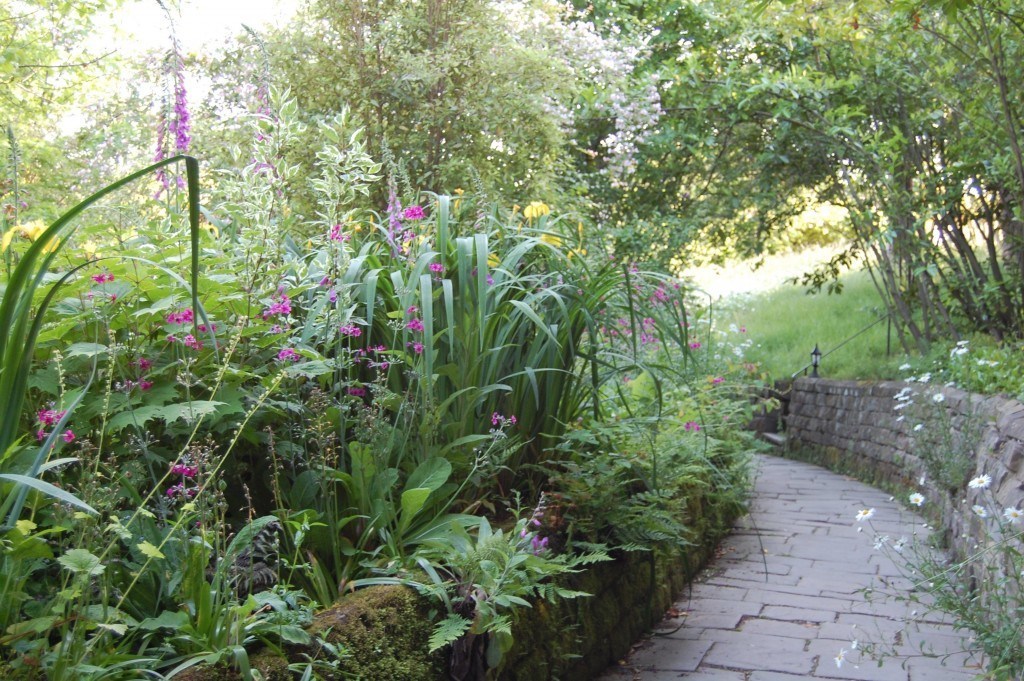
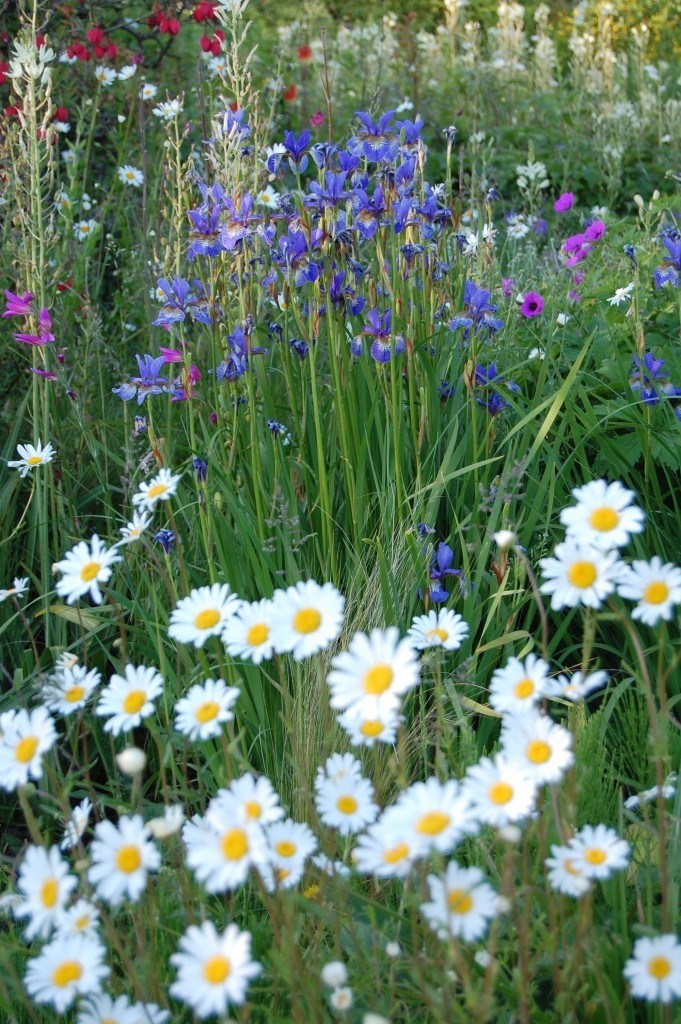
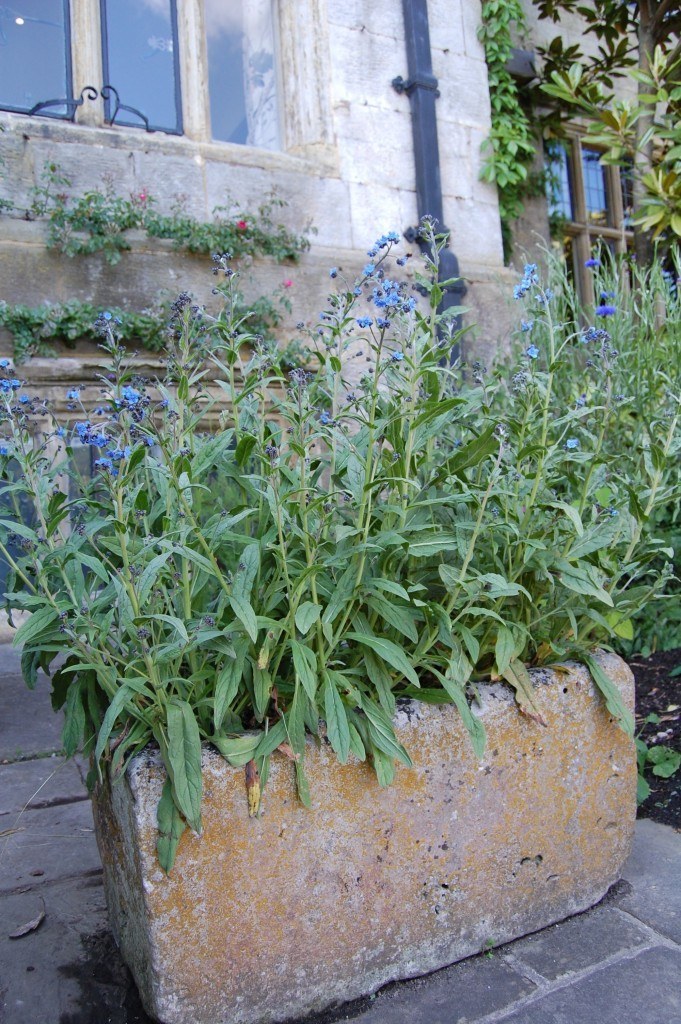
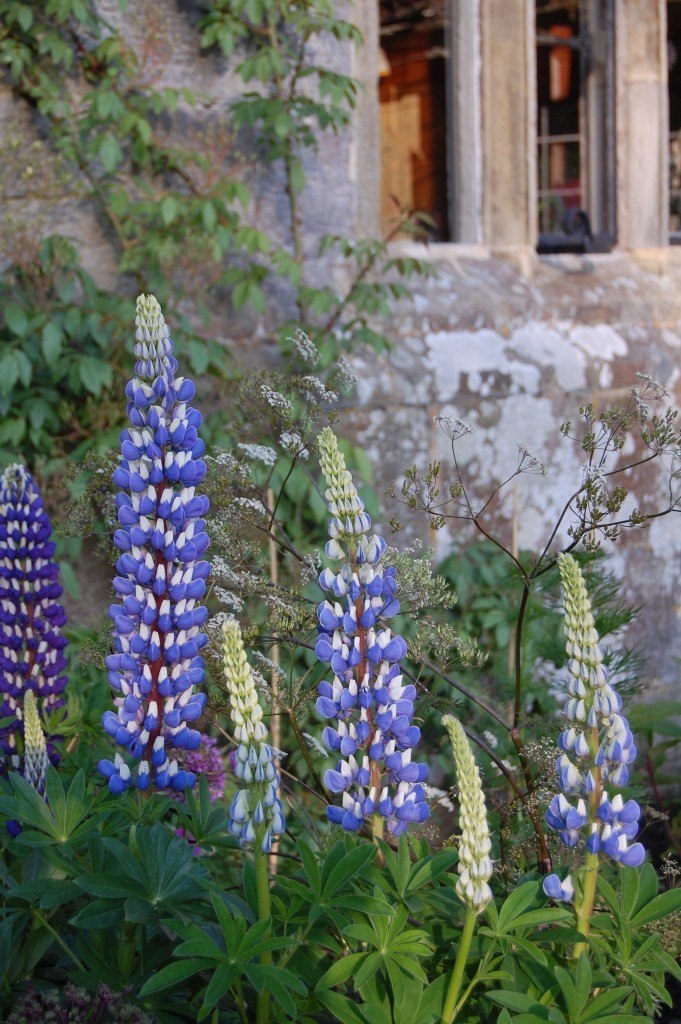
[custom-related-posts title=”Related Posts” none_text=”None found” order_by=”title” order=”ASC”]
AN AUTUMN STROLL THROUGH GEORGETOWN’S DUMBARTON OAKS
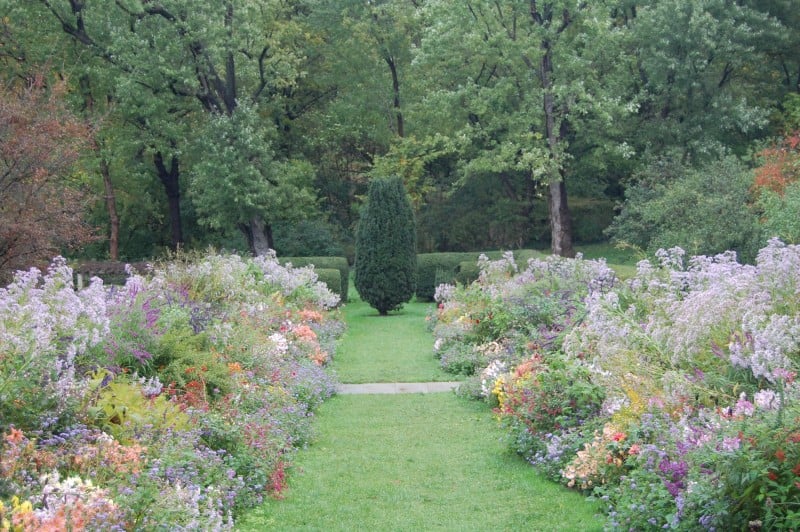
Visiting Dumbarton Oaks is always a treat, but last October, a walk through the grounds was particularly special as I got to tag along with Lynden Miller (left, below) and Gail Griffin (right, below). The two long-time friends are icons in the world of American landscape gardening.
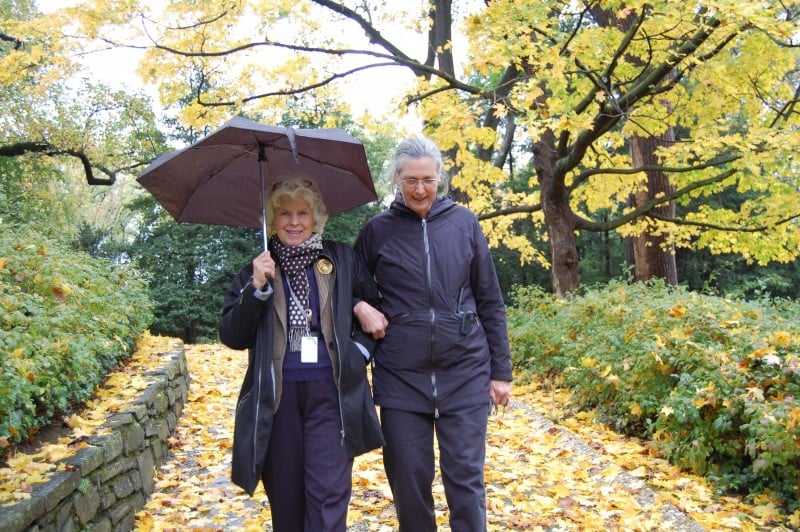
New York City public landscape designer Lynden Miller rescued and restored Central Park’s Conservatory Garden, among many other public gardens. I wrote about Lynden’s inspiring work and her influence on the public spaces movement in Richmond in a prior blog post. On this cold rainy fall day, Lynden delivered a fascinating lecture to the Dumbarton Oaks Fellows about Beatrix Farrand, the landscape gardener who designed the Dumbarton Oaks gardens. After her lecture, Lynden and I joined Gail Griffin, Director of Gardens and Grounds at Dumbarton Oaks, for a stroll through the gardens.
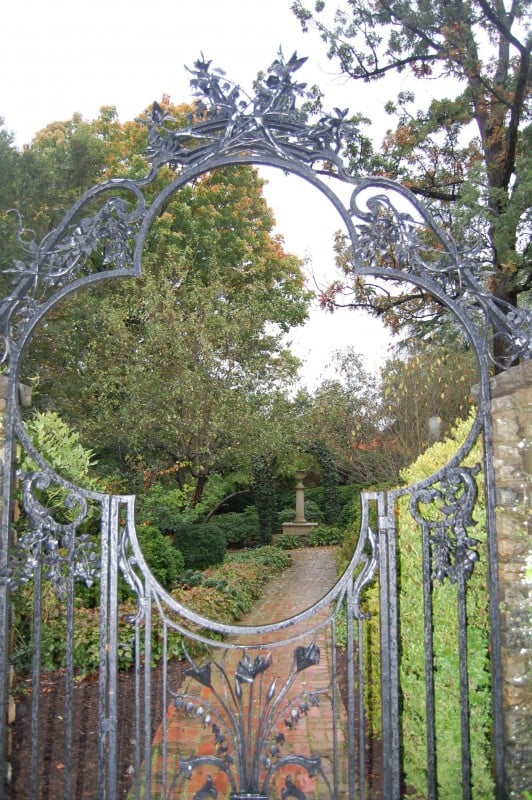
After a day spent on the grounds, it was clear to me that Gail is a beloved member of the Dumbarton Oaks family. She values and appreciates the many and varied contributions of her talented staff. Moreover, she deftly balances the sensitive and complex goals of preserving the design intent of Farrand and Mildred Bliss, while embracing the living landscape as it changes through the ages, the seasons, the days.
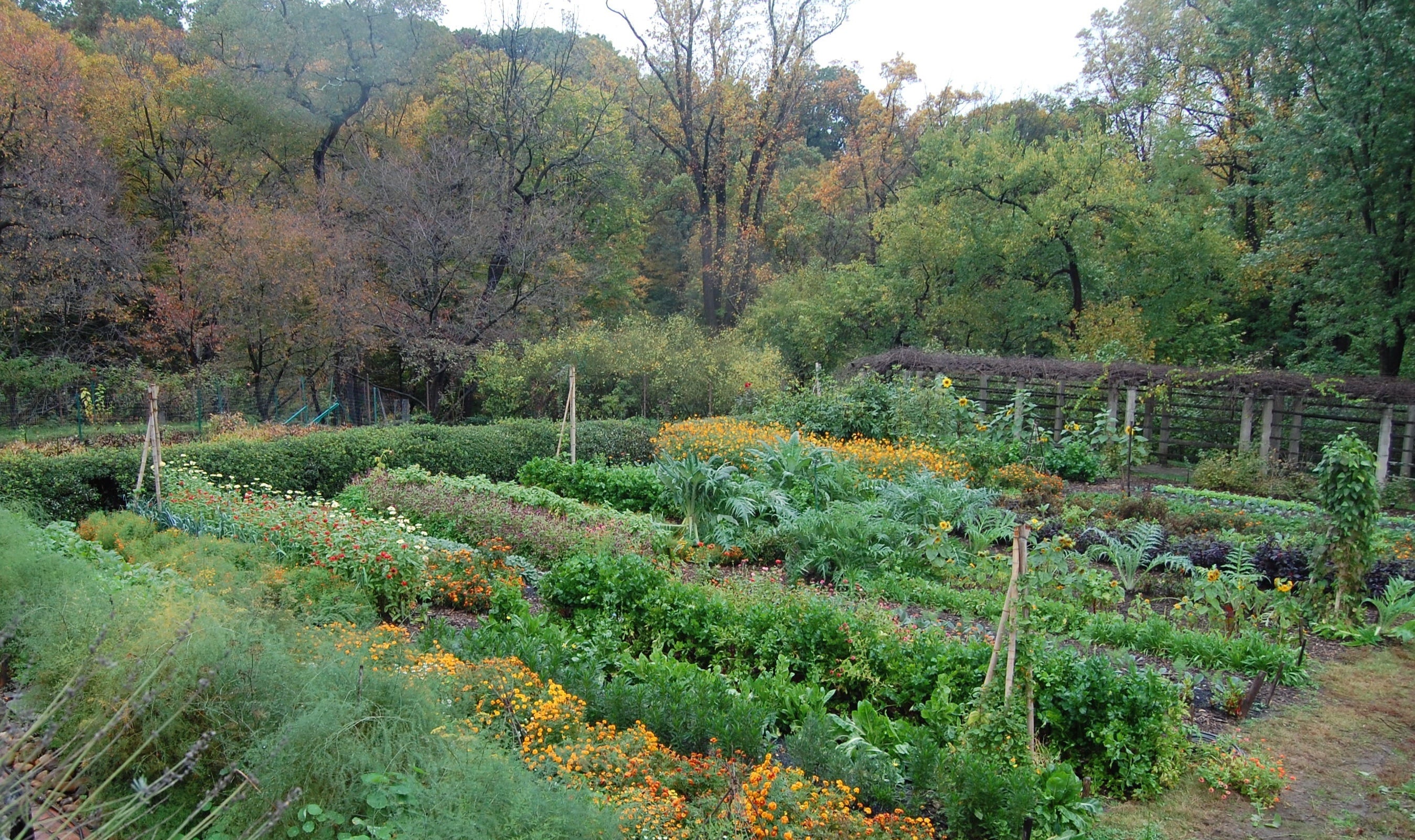
Under Gail’s leadership, the vegetable garden has been reinstated and enlarged. Over time she and her staff have added new vegetables, and new plant supports for the climbers and twiners.
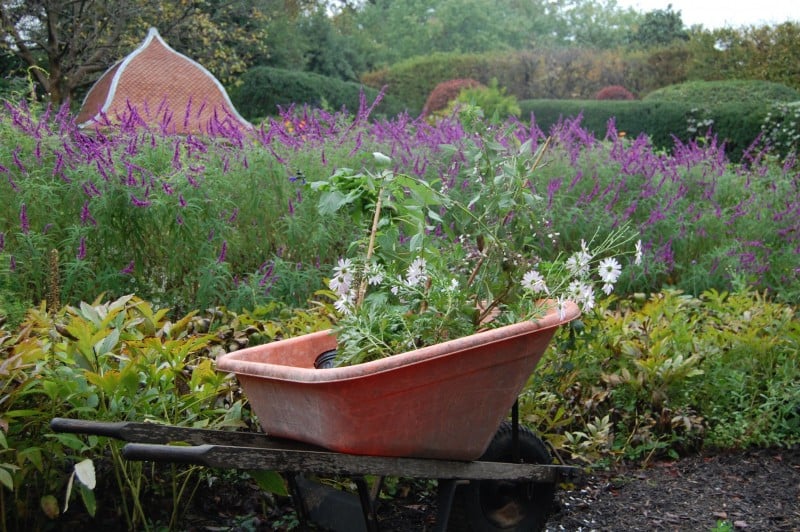
The cold and rain does not slow down the dedicated gardeners, who keep the garden looking
healthy and vibrant all four seasons.
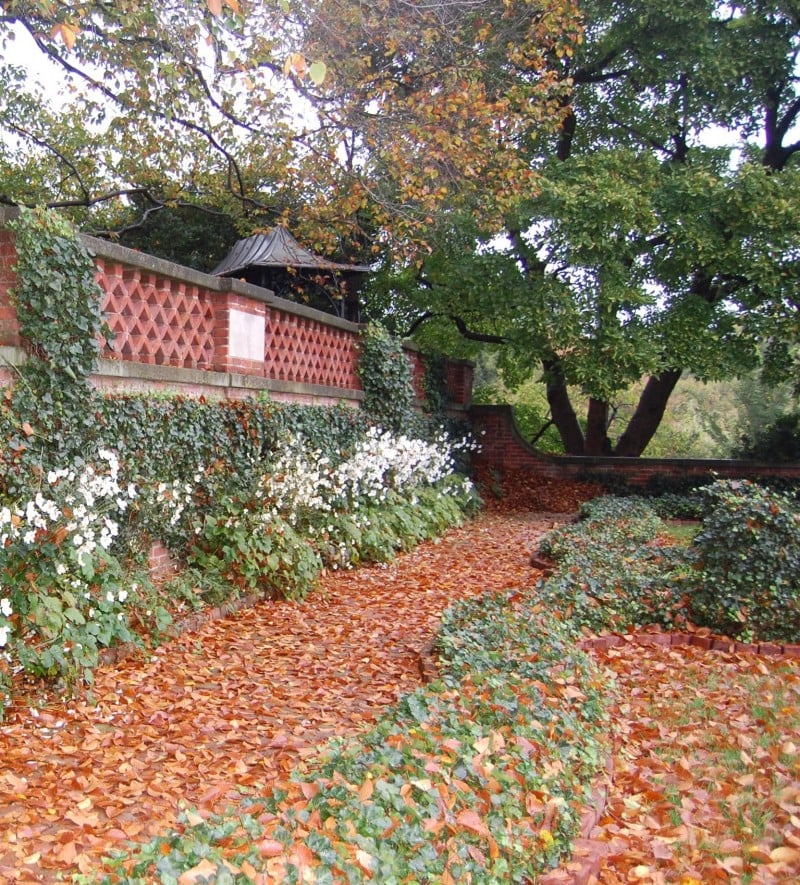
Japanese Anemone (Anemone japonica, above) blooms prolifically as the leaves fall.
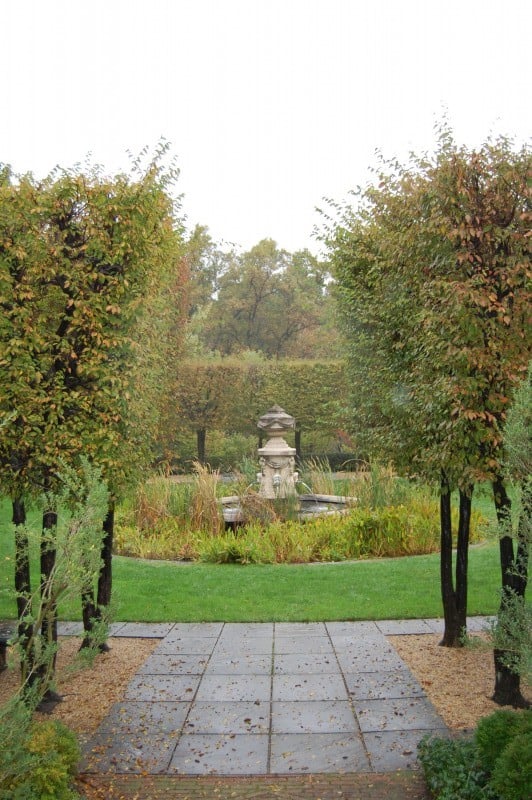
Griffin considers stormwater management and erosion control to be priorities for the Garden in coming years. She would like the pools and fountains to recirculate and she would like to capture and reuse more rainwater.
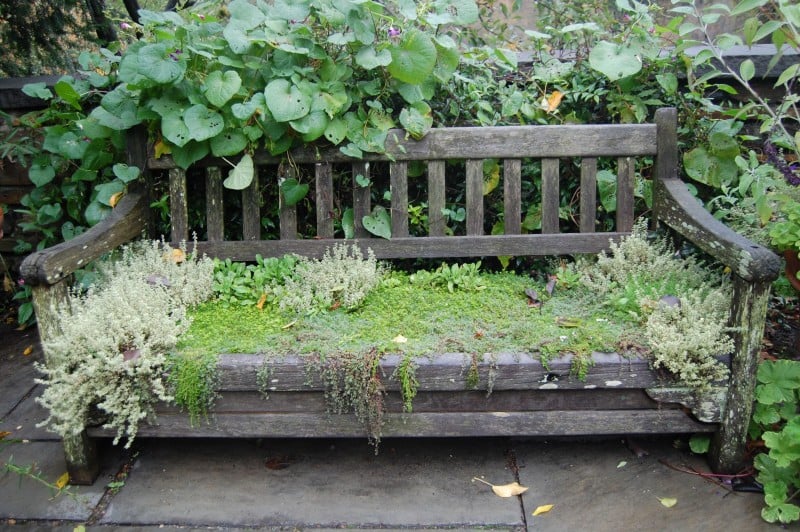
A seat in thyme . . .
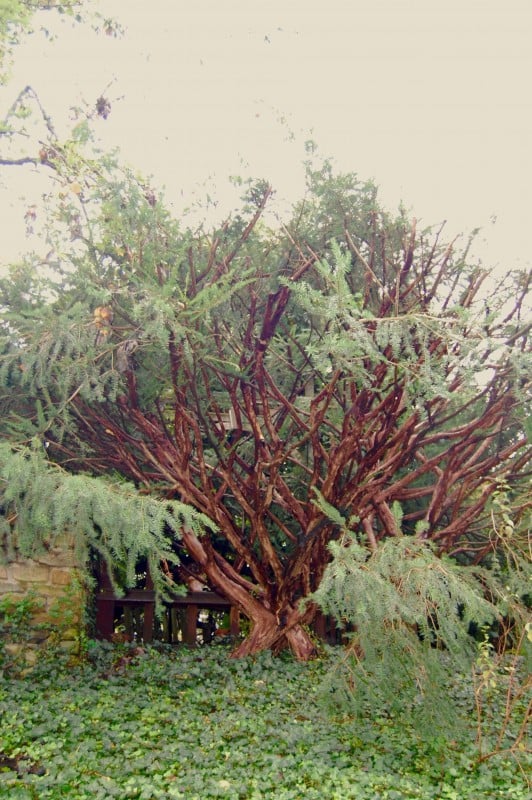
The rain accentuates the intricate branching of this Yew, above,
and the exfoliating bark of the tree (Lacebark Elm (Ulmus parvifolia)?) below.
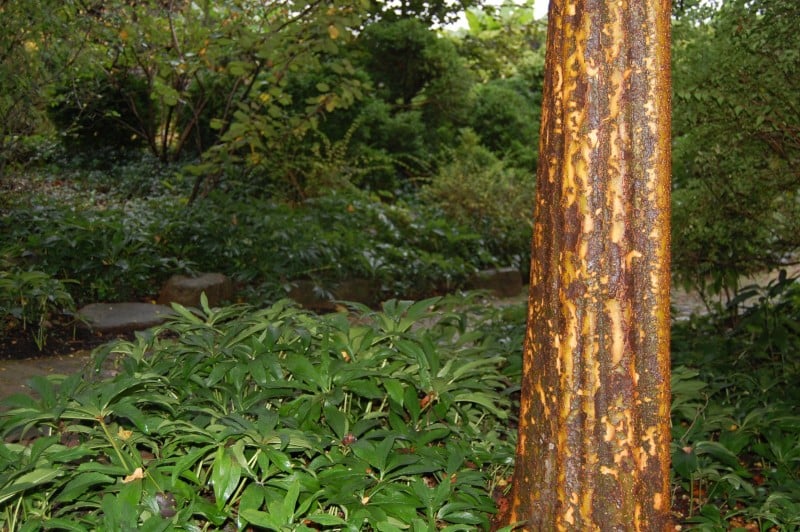
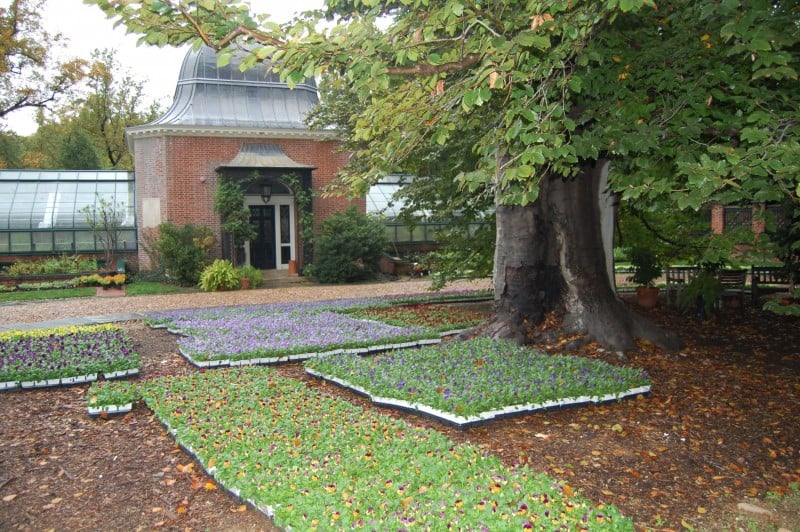
Thousands of Johnny Jump Ups and Pansies await planting. I learned from Lynden and Gail that
Johnny-Jump-Ups are hardier than pansies.

In her lecture, Lynden noted that Farrand felt strongly that aesthetics are an important part of an intellectual life. Farrand, the Blisses, Gail and scores of others have created, nurtured and strengthened the Garden over the last century for those who come by the thousands to this special place along Rock Creek Park.
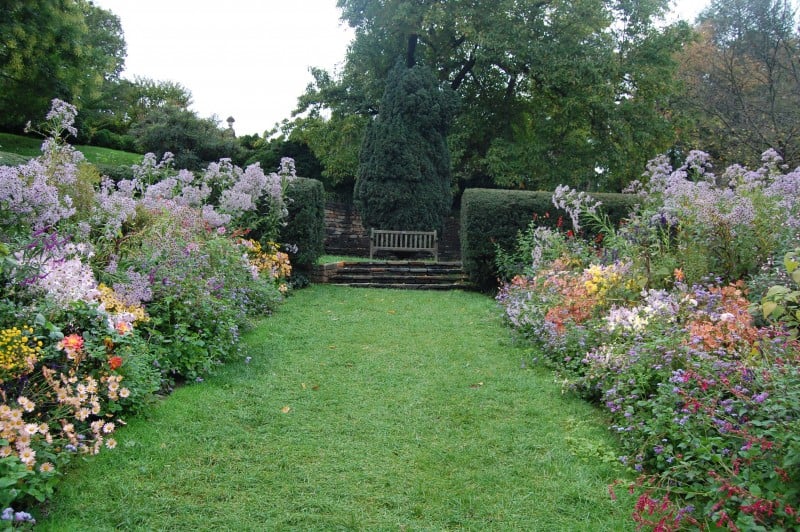
The beauty of Dumbarton Oaks speaks to all of the senses on this cool, wet October afternoon. As Gail said in an oral history interview, “People seem to see a spirit here, it’s almost an abundance, a tranquility. It’s a life lifted up to a higher level.” Amen.
An Autumn Stroll Through Georgetown’s Dumbarton Oaks

Visiting Dumbarton Oaks is always a treat, but last October, a walk through the grounds was particularly special as I got to tag along with Lynden Miller (left, below) and Gail Griffin (right, below). The two long-time friends are icons in the world of American landscape gardening.

New York City public landscape designer Lynden Miller rescued and restored Central Park’s Conservatory Garden, among many other public gardens. I wrote about Lynden’s inspiring work and her influence on the public spaces movement in Richmond in a prior blog post. On this cold rainy fall day, Lynden delivered a fascinating lecture to the Dumbarton Oaks fellows about Beatrix Farrand, the landscape gardener who designed the Dumbarton Oaks gardens. After her lecture, Lynden and I joined Gail Griffin, Director of Gardens and Grounds at Dumbarton Oaks, for a stroll through the gardens.

After a day spent on the grounds, it was clear to me that Gail is a beloved member of the Dumbarton Oaks family. She values and appreciates the many and varied contributions of her talented staff. Moreover, she deftly balances the sensitive and complex goals of preserving the design intent of Farrand and Mildred Bliss, while embracing the living landscape as it changes through the ages, the seasons, the days.

Under Gail’s leadership, the vegetable garden has been reinstated and enlarged. Over time she and her staff have added new vegetables, and new plant supports for the climbers and twiners.

The cold and rain does not slow down the dedicated gardeners, who keep the garden looking
healthy and vibrant all four seasons.

Japanese Anemone (Anemone japonica, above) blooms prolifically as the leaves fall.

Griffin considers stormwater management and erosion control to be priorities for the Garden in coming years. She would like the pools and fountains to recirculate and she would like to capture and reuse more rainwater.

A seat in thyme . . .

The rain accentuates the intricate branching of this Yew, above,
and the exfoliating bark of the tree (Lacebark Elm (Ulmus parvifolia)?) below.


Thousands of Johnny Jump Ups and Pansies await planting. I learned from Lynden and Gail that
Johnny-Jump-Ups are hardier than pansies.

In her lecture, Lynden noted that Farrand felt strongly that aesthetics are an important part of an intellectual life. Farrand, the Blisses, Gail and scores of others have created, nurtured and strengthened the Garden over the last century to ensure it provides that component to those who come by the thousands to this special place along Rock Creek Park.

The beauty of Dumbarton Oaks speaks to all of the senses on this cool, wet October afternoon. As Gail said in an oral history interview, “People seem to see a spirit here, it’s almost an abundance, a tranquility. It’s a life lifted up to a higher level.” Amen.
[custom-related-posts title=”Related Posts” none_text=”None found” order_by=”title” order=”ASC”]
PLANTS THAT WELCOME THE DELUGE
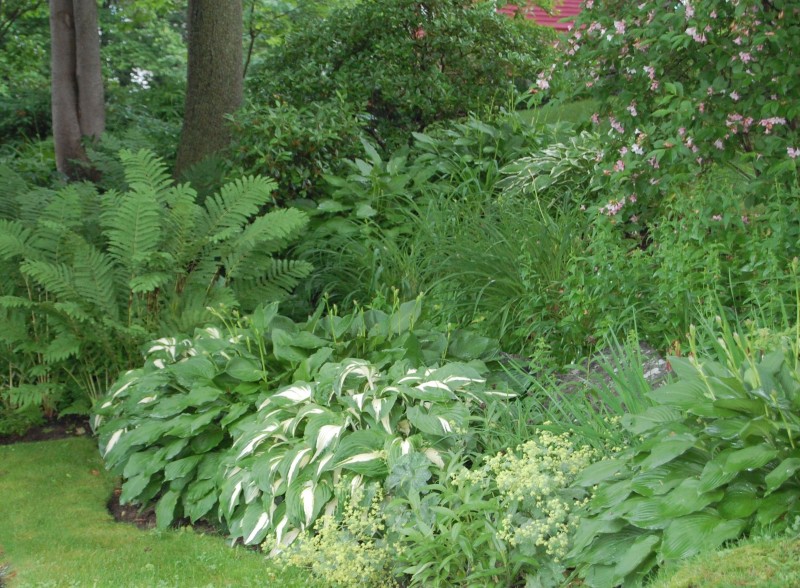
After the gazillionth inch of rain along the east coast, thanks to a tango being performed by Joaquin and a pesky nor’easter, it seemed appropriate to fire off a list of plants that will tolerate, and even welcome, wet soil. I took the picture above while visiting Camden, Maine during one of its wettest months on record. Ferns and Hostas are perfectly happy under such conditions.
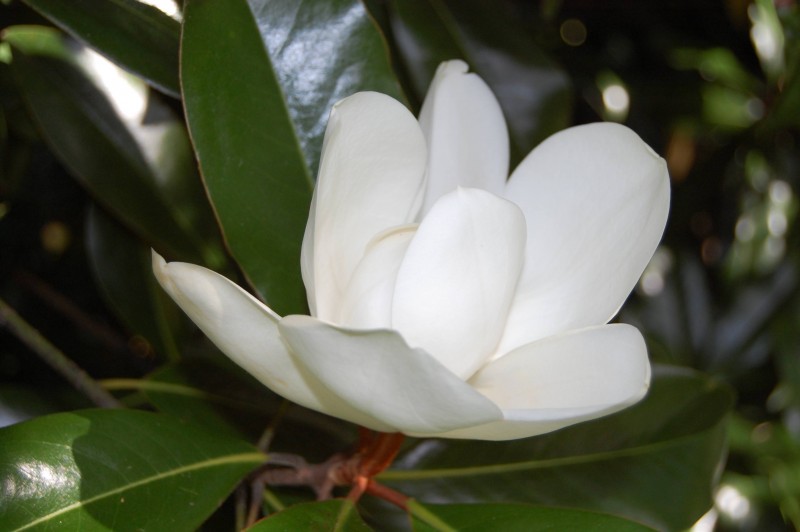
Magnolia grandiflora (Southern Magnolia) is native to Virginia.
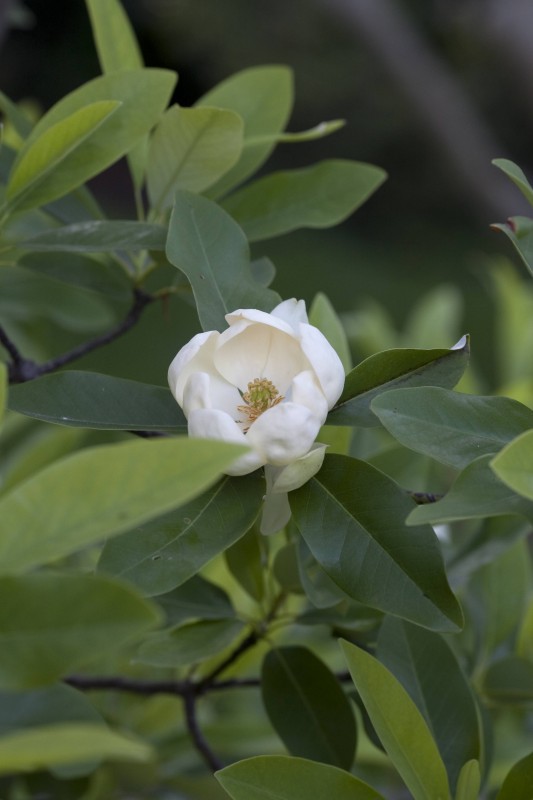
Magnolia virginiana (Sweetbay Magnolia) is native to Virginia.
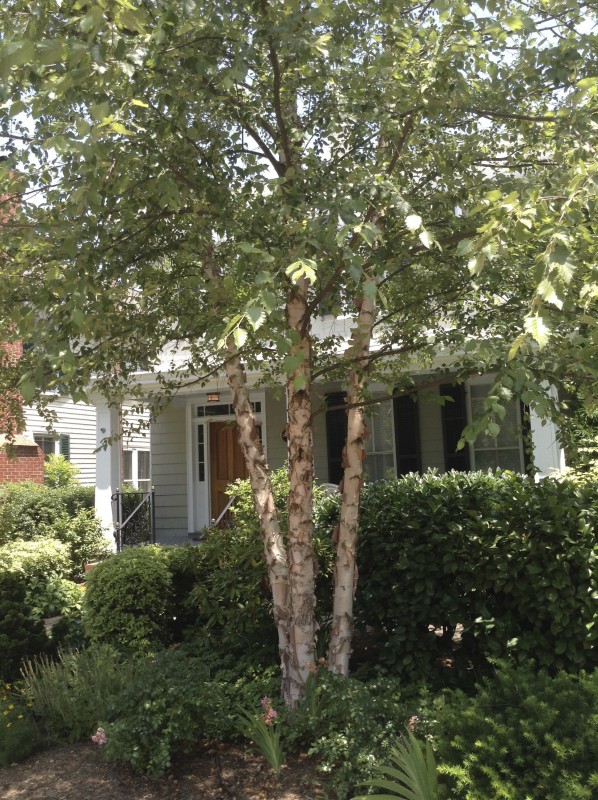
Betula nigra (River Birch) is native to Virginia.

Hydrangea (Hydra=water), with the exception of Oakleaf Hydrangea, tolerates wet soil. Above is the classic Hydrangea macrophylla.
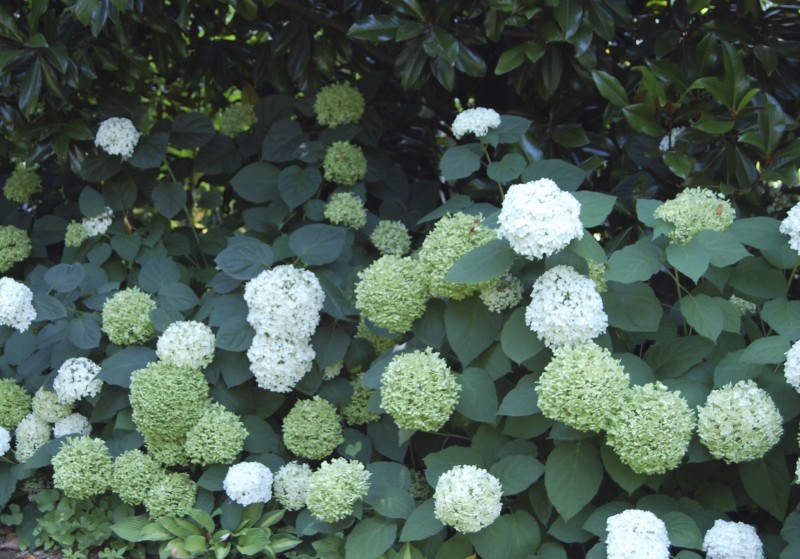
Hydrangea arborescens ‘Annabelle’ (Smooth Hydrangea); the species is native to Virginia.
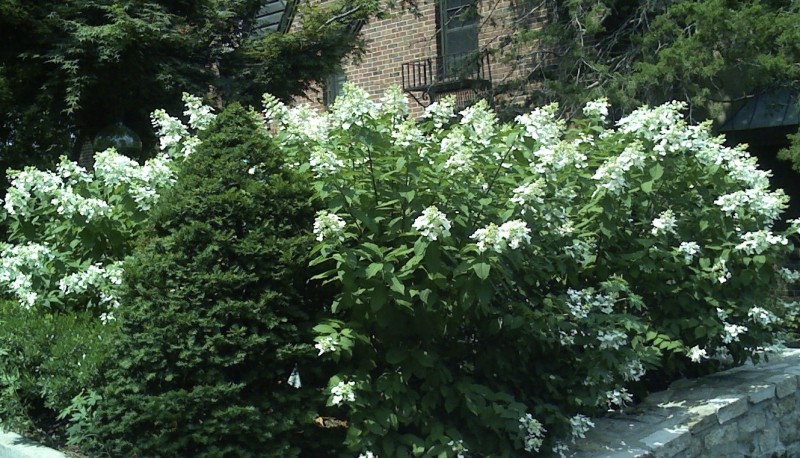
Hydrangea paniculata ‘Tardiva’ (Limelight and Pee Gee are other cultivars of this species)
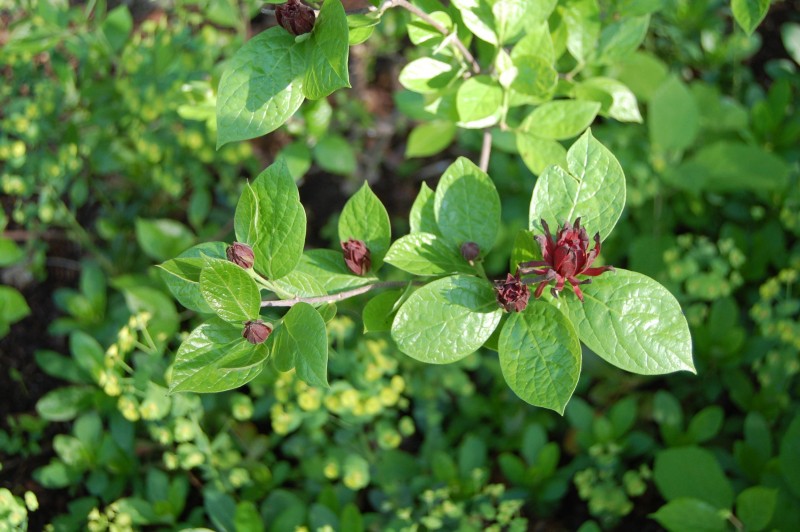
Calycanthus floridus (Eastern Allspice) is native to Virginia.
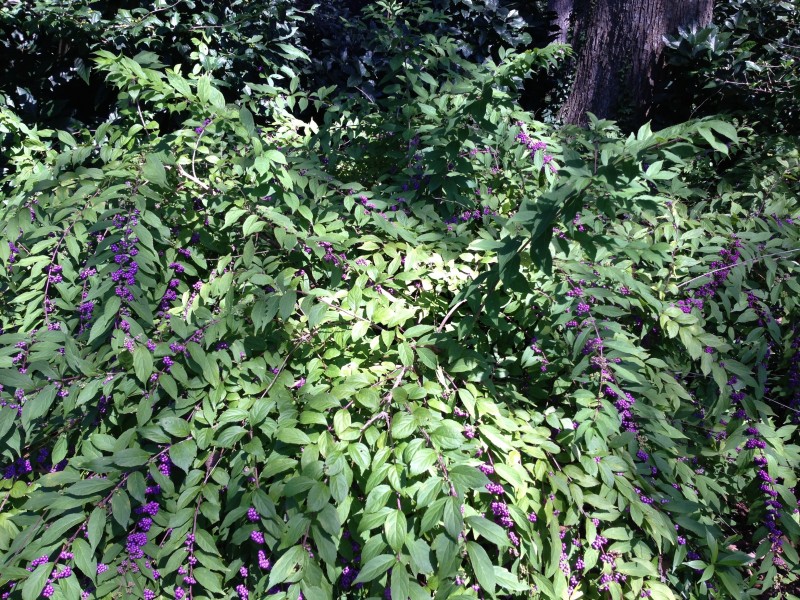
Callicarpa americana (American Beautyberry) is native to Virginia. I took this picture along a trail on Jamestown Island.

Aronia arbutifolia (Chokeberry) is native to Virginia.
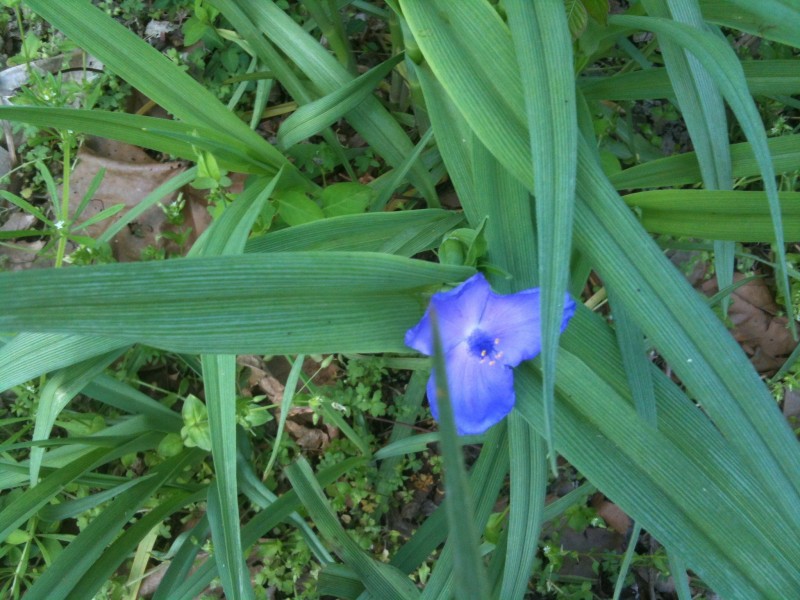
Tradescantia virginiana (Virginia Spiderwort) is native to Virginia.
I took this picture on Richmond’s wild and natural Belle Isle.
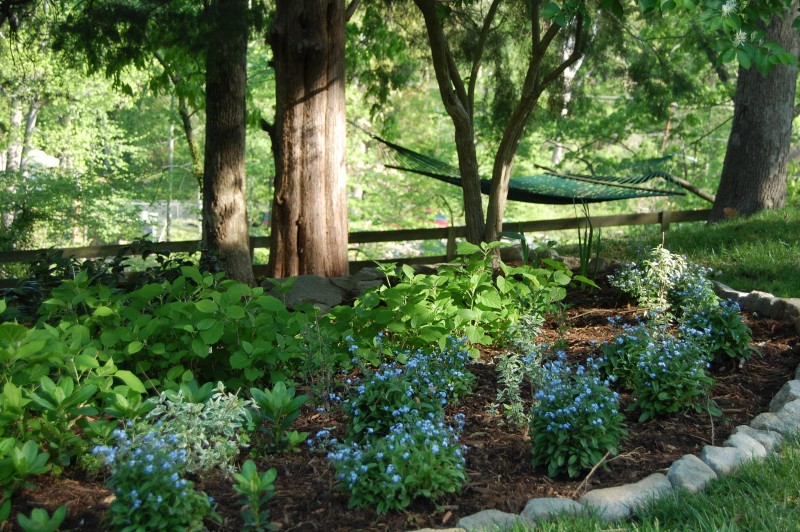
Myosotis sylvatica (Forget-Me-Not)
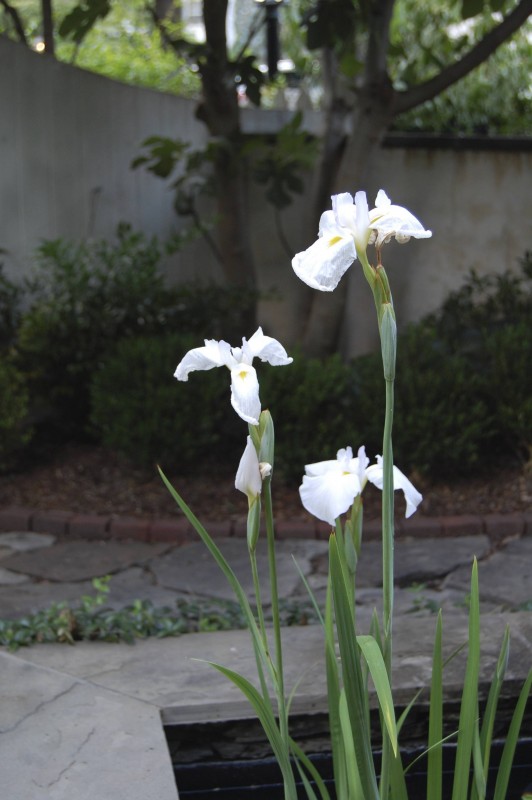
Iris siberica (Siberian Iris). Many Iris, including the native Iris versicolor (Blue Flag Iris)
will tolerate continuous bog conditions.
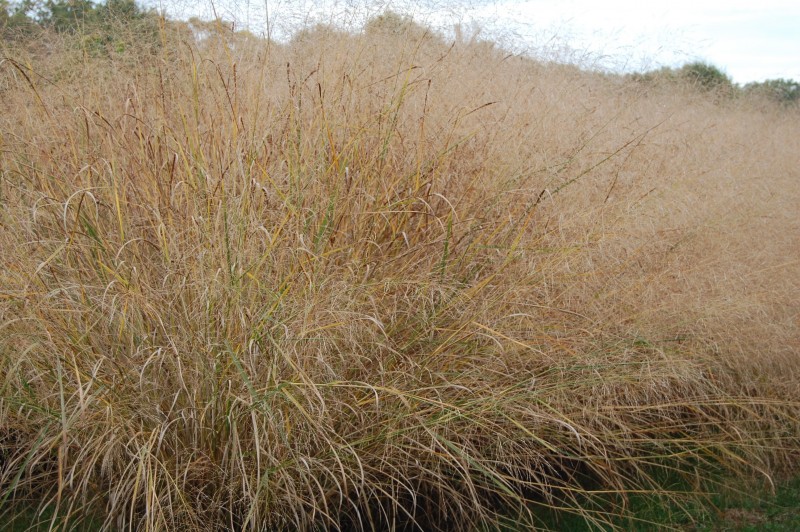
Panicum virgatum (Switchgrass) is native to Virginia.
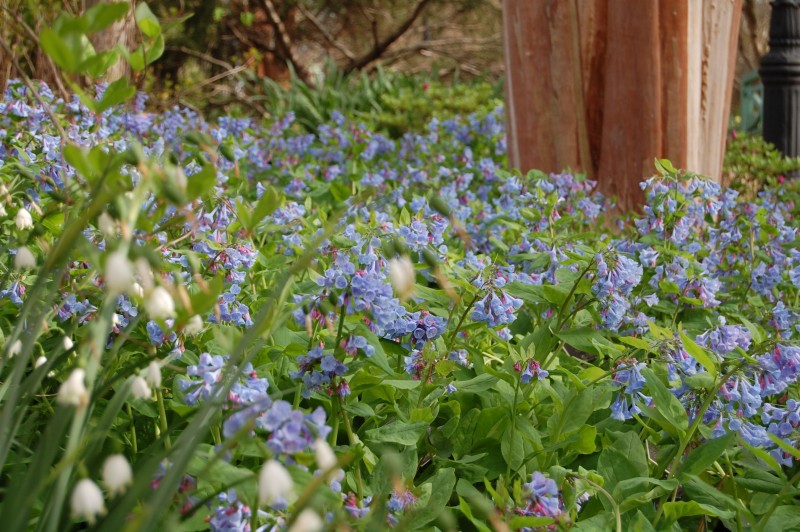 Mertensia virginica (Virginia Bluebell) is native to Virginia.
Mertensia virginica (Virginia Bluebell) is native to Virginia.
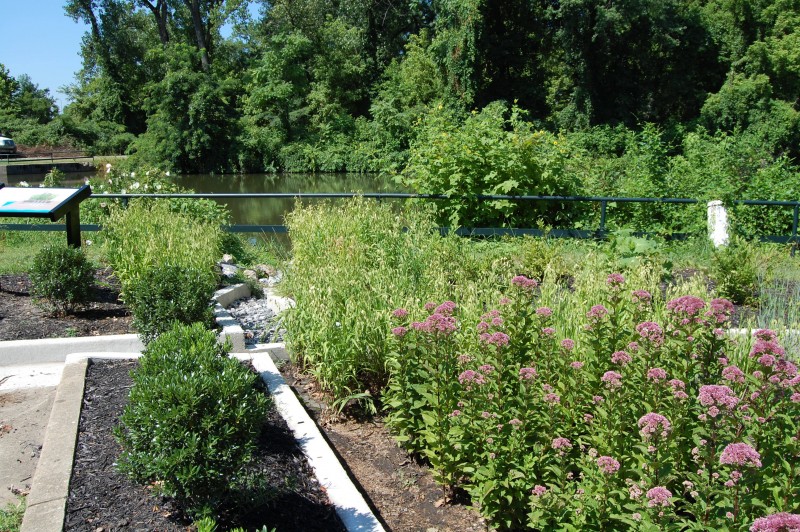 This rain garden (installed by Capital Trees as part of the renovation of Great Shiplock Park) filters polluted storm water from the park’s parking lot before it enters the historic James River and Kanawha Canal. Native plants, including Eutrochium purpureum (Joe Pye Weed), Chasmanthium latifolium (Northern Sea Oats) and Panicum virgatum (Switch Grass) thrive in the garden. Ilex glabra (Inkberry), Itea virginica (Virginia Sweetspire), Clethra alnifolia (Sweet Pepperbush) and Callicarpa americana (Beautyberry) — all native shrubs that tolerate wet soil– border the state-of-the-art biofiltration planters.
This rain garden (installed by Capital Trees as part of the renovation of Great Shiplock Park) filters polluted storm water from the park’s parking lot before it enters the historic James River and Kanawha Canal. Native plants, including Eutrochium purpureum (Joe Pye Weed), Chasmanthium latifolium (Northern Sea Oats) and Panicum virgatum (Switch Grass) thrive in the garden. Ilex glabra (Inkberry), Itea virginica (Virginia Sweetspire), Clethra alnifolia (Sweet Pepperbush) and Callicarpa americana (Beautyberry) — all native shrubs that tolerate wet soil– border the state-of-the-art biofiltration planters.
